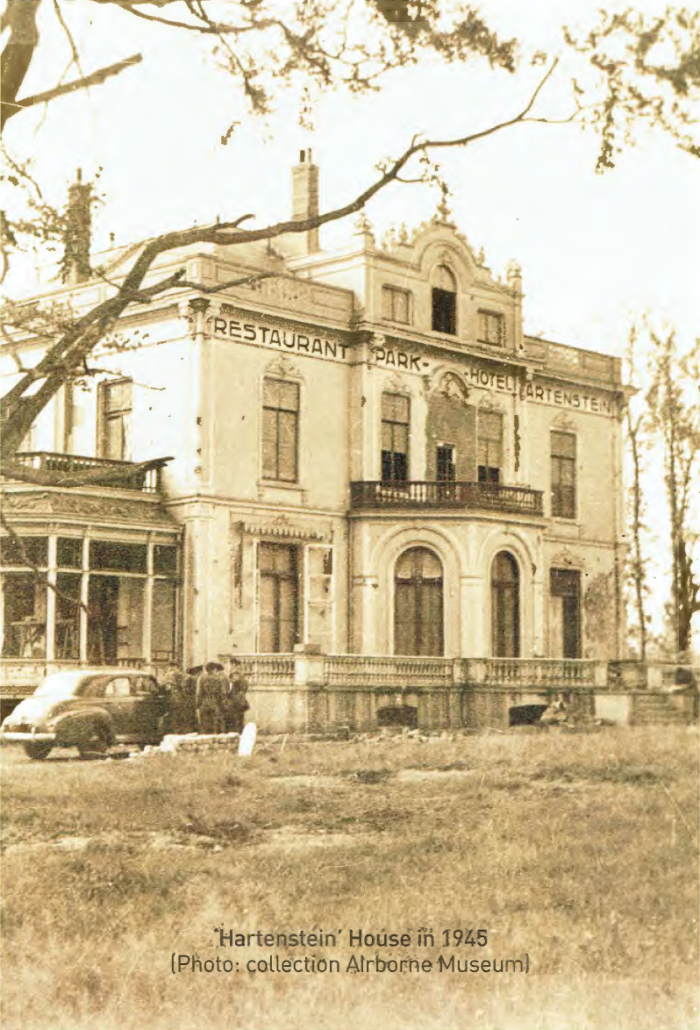CONTENT
3.-4. Wim Duyts leaves the Management of the Airborne Museum Foundation- Paul Tirion
4. News from Niall- Niall Cherry
4.-5. Tree for Sir James Cleminson, Part 2- Niall Cherry
5. The Weekend of the War Book’
5. Saturday 30 May 2015 -Experience Tour· The Battle of Arnhem from the German perspective
6. ‘Iconic Images’: the theme for Sunday 31 May- Marieke Helsen
7. New photographic books- Wybo Boersma
7.-8. Tanno Pieterse passed away- Robert Voskuil
8. Saturday 4 July 2015: Battlefield Tour to the Albert Canal and Fort Eben-Emael in Belgium
9. Parts of a Eureka beacon bought by the SFAM and donated to the Airborne Museum
9. Speakers invited
10. Who can design a logo for the SFAM?
10. Book about the ‘Denison Smock’- Wybo Boersma
11. Exhibition -‘Van Huis en Haard -Airborne Memo ries”, extended due to its success- Tessa Jansen
11.-14. Ministory 121 – The Royal Air Force ‘Air Liaison Group’ at Arnhem- Wybo Boersma
15. Program of the Society of Friends of the Airborne Museum, 2015.
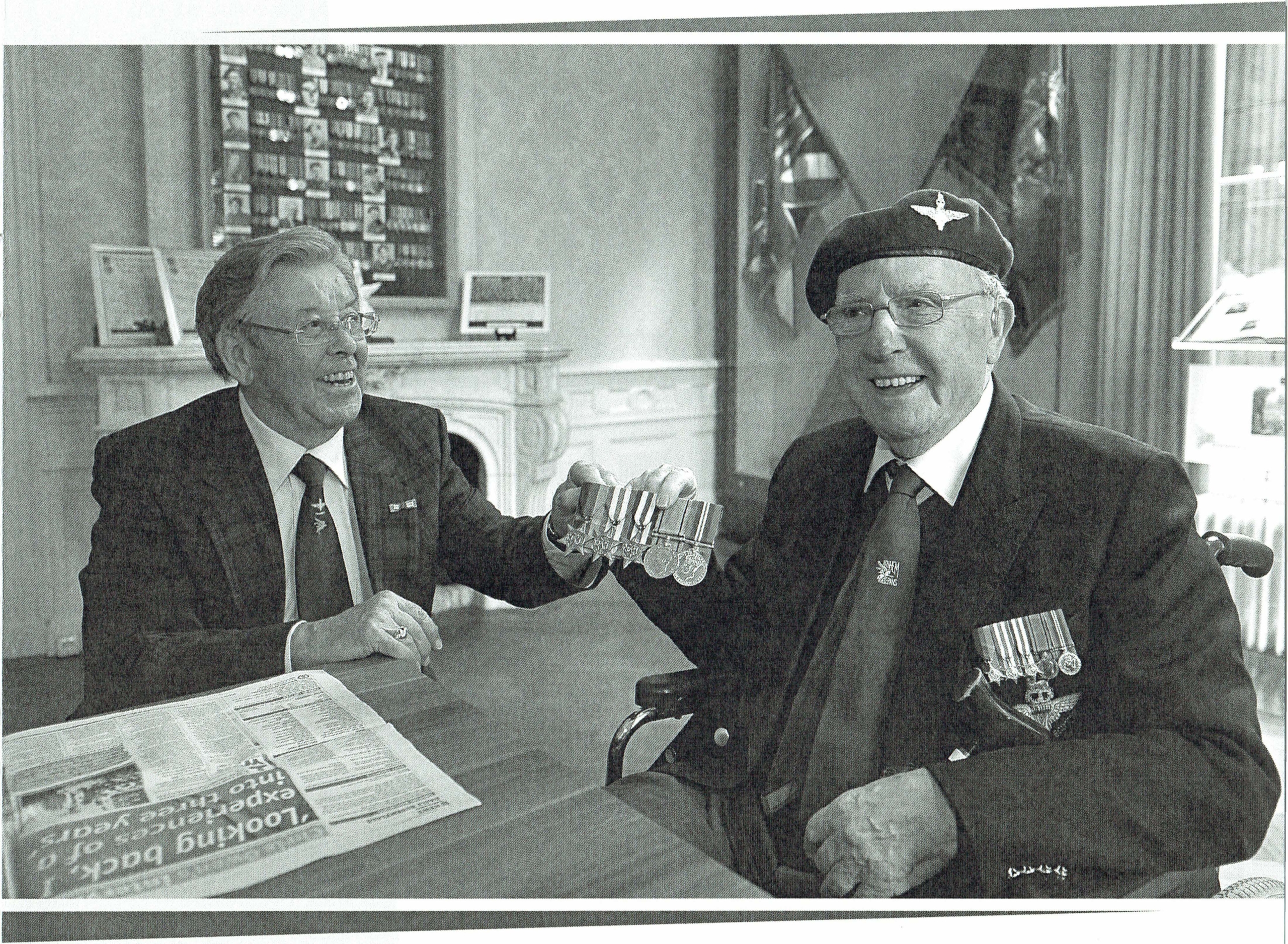
On 21 September 2011, 1n the Airborne Museum, Wim Duyts received the medal set from Mr Owen. veteran of the Battle of Arnhem
/photo: berrydereusfotografie.nl]
WIM DUYTS LEAVES THE MANAGEMENT OF THE AIRBORNE MUSEUM FOUNDATION
After nearly 45 years, on 30 January 2015, Wim Duyts retired from the Management of the Airborne Museum Foundation. Wim’s career at the Museum began on 10 November 1969, when he was elected as a member of the then called “Foundation for Cultural History in the Renkum Council area” with the sub title “Airborne Museum”. The Museum was then still based in the Doorwerth Castle. During his daytime life, Wim was an officer with the Royal Dutch Air Force, on the Deelen air base, and later in Nijmegen.
On 13 December 1977, Wim transferred to the newly formed “Airborne Museum Foundation”. Shortly before then, the Hotel-Restaurant Hartenstein in Oosterbeek, came to be empty and the Village Council had ap proved the plan to rehouse the Airborne Museum into the Hartenstein building. For Wim Duyts, but also for the management members, Wybo Boersma and Aad Groeneweg, a very busy time opened, because the big question was, “how do you renovate a neglected buil ding and fit it out as the Airborne Museum?” For the restoration and fitting out of the building, only 200,000 guilders, about €90,000, was available. This meant that much of the work had to be performed free of charge and thus much hard work had to be performed by a team of volunteers. Wybo Boersma laid out an instal lation plan and he worked on this, in close co-operation with the Renkum Council and the Dutch Army Mu seum. I think the whole period can be spoken about with great respect to all those involved. An enthusiastic group of people then worked amazingly hard for three months to produce an impressive museum.
On 11 May 1978, the Airborne Museum ‘Hartenstein’ was officially opened by Major-General Roy Urquhart. In the Jubilee year 1984, so many sets of medals from veterans were presented to the Museum, that it was decided therefore to create a suitable display.Wim Duyts took on this task and until todayWim has, as the specialist in this area, maintained this special ex hibition. That he has done with much knowledge of the subjects, but also very carefully, because all medals have been exactly displayed in a correct and attractive way. The · Hall of Fame· in the Museum, has also become ·a place of honour· for Wim.
An enthusiastic group of people worked extremely hard for three months to produce an impres sive Museum.
Wim also worked on the book ‘The Harvest of 10 years· (‘De Oogst van Tien Jaar’l. wherein a large number of accounts appear, written by veterans of the Battle of Arnhem. These stories were received in the first 10 years that the Museum was located in Hartenstein.
Also for several years, Wim attended the management meetings of the SFAM, as representative of the Airborne Museum Foundation.Wim had many contacts with veterans, as well as the BritishParachute Regiment, especially with the 10thParachute Battalion. He was also responsible for the contacts with the Royal Family, and he did that in an excellent manner.With the passing of the years,Wim had performed all formal functions in the manage ment of the Airborne Museum Foundation. That made him a perfect ‘all round’ member.
But above all,Wim was a precise secretary’ He was always closely involved with new developments within the Museum, also when in 2008-2009, the Museum underwent a substantial innovation. Throughout his 45 years long service,Wim was someone who the management could rely on for information and advice about all matters, having been involved in the long history of the Airborne Museum. The Foundation management will miss that support enormously. Wim, we thank you earnestly for all the work you have done over many years!
[Paul Tirion – Treasurer – Airborne Museum Foundation).
NEWS FROM NIALL
The 2015 membership cards were sent out by me to members who had paid for 2015 in early March and hope fully have arrived. If you think you have paid for 2015 and have not received it yet please contact me at my normal address. Plans for the June 2015 tour are well advanced and I look forward to meeting old and new friends on the ground then. The time since last September has seen a lot of Arnhem veteran friends sadly pass away no tably HaroldPadfield, Tony Hibbert and Ken Fleet. A memorial service was held in Aldershot for Tony Hibbert in February 2015.
SIR JAMES CLEMINSON, PART 2
Following on from the article in the previous Airborne Magazine about the Sir James Cleminson tree, un veiled in September 2014, 200 copies of a booklet on his life were produced by the Arnhem 1944 Fellowship, which were given away to members who attended the unveiling. A few details on the life of Sir James which may be of interest prior to his Arnhem adventures: James Arnold Stacey Cleminson was born on Au- gust 31 1921 in Hull, where his father, Arnold, was chairman of Reckitt & Co, a starch manufacturer which merged in 1938 with J&J Colman of Norwich, best known for its mustard. His mother, Dr. Florence Stacey-Cleminson, was a pioneering physician at Hull’s Victoria Children’s Hospital. James was educated at Rugby, and according to the 1939 Hart’s Army List he is shown as a 2nd Lieutenant on the Royal Artillery Territorial Army, Supplemen tary Reserve list with dates of 27th May 1939 and 24th August 1939.We believe the first date is his ·seniority’ date and the second the date of his appointment. From there the trail goes cold until May 1941 when he ap pears as commissioned into the Cheshire Regiment with an Emergency Commission date of 31st May 1941 and his rank given as W/S Lieutenant War Substantive and he is shown as remaining with this Regiment until October 1942.
The 3rdParachute Battalion war diary shows him being posted in from the 70th Battalion King·s Royal Rifle Corps on 13th July 1942. This unit was a ‘young sol diers· battalion and had been on home defence duties since it was formed after the outbreak of the war. Inte restingly this unit’s war diary shows him on 22nd June 1942 as being posted to XI Corps Defence Company as a 2nd Lieutenant, with Cheshire Regiment shown in brackets afterwards. In any case it seems the air borne world was starting to worm ifs way into the 70th KRRC as war diary entries indicate – 11th April 1942 volunteers [125] for Airborne Division seen by Special Interview Board, 51 were eventually accepted.
Was Sir James one of these? Then in October 1942 the Battalion was paraded and informed that it was to be disbanded. The War Diary records, “Major Luard of the Paratroop Regiment called for volunteers. About 80 OR’s responded to this and were immediately exa mined. TheParatroop MO rejected less than 5%.”
We assume that Sir James went fairly quickly on a pa rachute course at Ringway, most likely in August 1942. Unfortunately there is no trace of him going through Ringway in the records, with records sadly missing for two courses during this month.
There is an entry in 3rdParachute Battalion War Diary for 18th December 1942, 1800 hoursPatrol under command Lieutenant JAS Cleminson sent forward to contact Lieutenant FWM Sharman MC”. This is the last entry of Sir James for 1942 and it is known that he was taken prisoner at about this time and was transferred to aPOW Camp in Italy soon afterwards. He managed to escape from his Italian prisoner of war camp and reached British lines in September 1943, after the capitulation of the Italian Army.
So by the summer of 1944 Sir James was a 23 year old platoon commander with the responsibility for running 5Platoon of B Company of the 3rdParachute Battalion and I think it is relatively well known what happened to him at Arnhem.
Given that a lot of Society members are avid collectors of printed material it can be said I feel that ‘He Inspired His Men with His Offensive Spirit’ may now be placed on a few people’s wish lists I [Niall Cherryl
THE WEEKEND OF THE WAR BOOK’
During the weekend of Saturday 30th and Sunday 31st May 2015, the Airborne Museum ‘Hartenstein’, in collaboration with the Society of Friends of the Airborne Museum, will again hold the annual Weekend of the War Book·. On Saturday 30 May, the traditional Book Fair will take place. Around the Museum will stand about 40 bookstalls. The various stallholders offer a choice of second-hand books about all aspects of WW2.
The Book Fair will be open from 10.00am until 3.00pm. Entry is free, but entry to the Museum itself,
will attract normal entry fees. See also: www.airbornemuseum.nl and www.vriendenairbornemuseum.nl . For further information: W. Boersma; Tel/Fax: 0318-639633.
SATURDAY 30 MAY 2015 – ‘EXPERIENCE TOUR’ – THE BATTLE OF ARNHEM FROM THE GERMAN PERSPECTIVE’
If you wish, it will be possible to combine a visit to the Book Fair with a walk, that will take place on Saturday afternoon 30 May and is organised by the SFAM, in conjunction with ‘ Between Dutch and Deutsch·. This walking tour around Oosterbeek, led by our member, Ingrid Maan, will focus on the Battle of Arnhem from the German side. The tour will concentrate on the personal experiences of German military personnel. The tour will begin at 13.30hr at the Airborne Museum entrance. The fee for those taking part, will be€7,50 for members of the SFAM and the ‘Arnhem 1944 Fellowship’. Non members will pay€10,00. These fees include the guided tour after which, a drink in the Schoonoord Restaurant in Oosterbeek, when no doubt further discussions will occur. Booking can be made by money transfer of€7,50 €10,00) to account: IBAN: NL33 INGB 0005 1137 51 in name of Vrienden van het Airbornemuseum, Oosterbeek, under reference ‘ Belevings-tour 30 Mei’. You will only be contacted if the tour is fully booked.
ICONIC IMAGES :THE THEME FOR SUNDAY 31 MAY
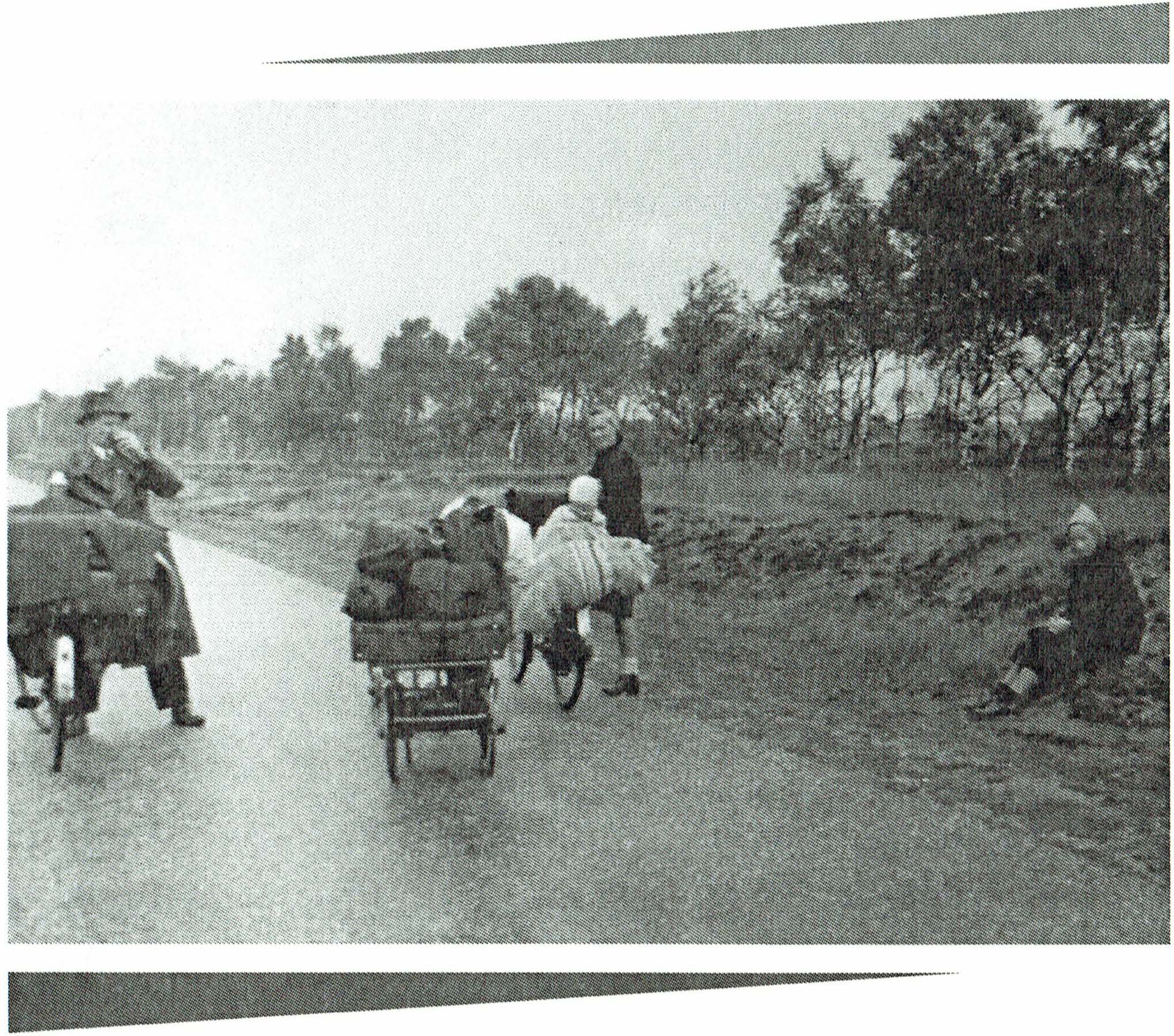
Evacuation ofArnhem, September 1 944. Citizens flee the city Sitting on the verge, is the p regnant Beb Timmerman, she fled with her husband and children (not in the photo) in friendly company with Jan and Emmie Willemsen and their child, who are in the photo.
(Photo Airborne Museum gifted collection 201 5)
From old shoe boxes filled with photos, film rolls and from old yellow stained photo albums, a continuous stream of pictures are offered to all types of museums and archives. Frequently, old and previously unseen pictures app ea r. Some of these images are taken up by the media, such as the 31 photo rolls that recently surfaced in the USA. The photos were taken by a mili tary man, who served in Europe in 1 944 and 1 945 . This is unique material. Also, the Airborne Museum re ceives such offers of new material on a regular basis. Amongst these are often found valuable pictures about the Battle of Arnhem and of the evacuation that follo wed. Exce pt for those close to the family, these photos are not usually known and seen by others. By donating such photos to the Airborne Museum, it becomes pos sible to make the photos available to a greater public. Many of these photos are very impressive, due to their com position and the historic moment when they were taken. You could call them ‘iconic images· . But they bring new questions with them. Can newly uncovered photos still be ‘iconic images· 70 years after they were taken?
In September 201 4, two renowned Dutch authors, Ingrid D. Jacobs and Joost Rosendaal, each published their own book of photos. Alongside the many splendid photos both authors add their own personal stories. Both authors will talk about their books on Sunday 31 May 2015 at the Airborne Museum from 1 4. 00hr until 1 6.00hr.
Ingrid D. Jacobs, freelance writer and academic journalist, studied Dutch language and literature and writes about culture and history. She has an impres sive collection of works produced under her name.
Last year she published ‘Arnhem 40-45′, a book in which, with both hundreds of photos and text, the story of Arnhem during theWar is told. She chose photos from German, Allied and Dutch photographers and she attempted to show the daily life of a city under oc cupation and during theWar.
Joost Rosendaal is, as a university lecturer in politics and cultural hi story, attached to the faculty Language and Literature at the Radboud University in N ijmeg en. In earlier interviews, he made a clear similarity bet ween images ofWW2 and more modern images of war and he pointed to the fact that the comme moration of freedom and peace is and remains very im portant.
In his book “The Liberation in pictures, from Neerpelt toWesel 1 944-45’, he illustrates the various aspects of the battles and the liberation of the South East Nether lands and the Rhineland area.
Both authors will speak on Sunday afternoon 31 M ay, about their work. They will also be interviewed and will also happily discuss with those attending . The introduction will be performed by Marieke Helsen, the Airborne Museum Curator. Please app ly to attend via aanmelding@airbornemuseum.nl – there is no extra charge for the lecture – the normal tariff of charg es can be seen at: www.airbornemuseum.nl .
(Marieke Helsen]
NEW PHOTOGRAPHIC BOOKS
Last year, a variety of books were published that dealt with Operation M arket Garden, in part or whole. As mentioned above, two of these books will be discussed by their authors on Sunday afternoon 31 May, at the Airborne M useum. Ingrid D. Jacobs wrote her book ‘Arnhem 40-45’ , published by W. Books, in collaborati on with the Gelders Archive. The book offers photos of Arnhem from the p eriod 1940 until and including 1945. From the large number of photographs that exist at the various archives, the author has m ade a balanced choice. Jacobs has divided the content into nine chap ters, from the pre-war Arnhem, until and including the return of the citizens and the start of the rebuilding of the city after the end of the War. Each chapter begins with a brief introduction. The photos are provided with a broad explanatory text. In writing these texts, Jacobs had support from various experts. Even so, a couple of mistakes have occurred, especially in the chapter ‘The Battle of Arnhem· . Horsa gliders (p.56) did not carry light tracked vehicles, they were transported with the Hamilcars. The caption of the photo of a German soldier at the Oude Kraan in Arnhem on Page 66, is incorrect. The soldier is not carrying a map case, but a case for a flare pistol and a bag for the flare rounds. I In a better print of this photo in the book ‘ Kampfraum Arnheim’ can be seen that on the ar mband does not appear ‘ Hohenstaufen· but a skull symbol of the 3° SS Panzerdivision ‘Totenkopf. The photos are all printed matt: possibly a gloss print had produced a clearer image. But otherwise, the book is nicely produced and gives a good picture of the wartime period in Arnhem.
The second book is by Joost Rosendaal and covers the period from September 1944 until May 1945, in the area from Neerpelt to Wesel. For this book as well, it is true that Rosendaal had to choose from the thou sands of photos that were taken during this time. The book includes many known but also some less well known photos. The same as with Jacobs, each chapter starts with a brief introduction, sometimes with small maps. The photos by contrast, have shorter captions. These captions howeve r, give more details than those in the Jacobs book. If we look at the same photos in each book, we notice the difference in captions. For exam ple, the caption of the well known photo of the evacuation of civilians from the St Elizabeth’s Gasthuis, is dated by Jacobs on 26 September ( Page 65) and by Rosendaal on 19 September [ Page 79] . The truth is that the photo was taken on 19 September 1944, by the Germ an war photographer Wenzel.
The more you study these photos, the more interesting details you see. The book gives a good overview of the whole period 1944-45 in the area between Neerpelt [the beginning of the Operation M arket Garden) and the German town of Wesel [the end of the Rhine Cros sing].
Neither books should be missing from the book-case covering Operation Market Garden.
‘Arnhem 40 -45’ by Ingrid D. Jacobs. ISBN 978 94 625 8038 1, Publisher W. Books, Zwolle, in co-operation with Gelders Archive, 111 pages, illustrated, €24,95. ‘The Liberation in pictures, From Neerpelt to Wesel 1944-45’ (De bevrijding in beeld, Van Neerpelt tot Wesel 1944-45) by Joost Rosendaal, ISBN 978 90 8145 000 3, Publis hed by Uitgave Vantilt/Fragma. N ijmegen 2014 , 255 pages, illustrated €27,50 . [Wybo Boersma)
TANNO PIETERSE PASSED AWAY
Sadly, on 10 January 2015, our 87 year old member Tanno Pieterse, from Bennekom passed away. Tanno was well known by everyone who was involved with the annual Airborne commemoration.
As a 16 year old youngster, he experienced the Battle of Arnhem from very close by and that period forever left a deep impact on him. [See Ministory 117- “A binding memory of a time that you never forget”, News letter 131 – September 2013) .
In 1969, it was suggested that, after 25 years, the official commemoration of the Battle of Arnhe m should come to an end, because people expected that the interest from the UK, Poland and the Netherlands would then rapidly disappear. Various local commit tees who had organised all the various aspects of the annual pilgrimages were disbanded. But, in the then following year, it appeared that in fact, there was no discussion about a diminished interest. In fact, there arrived more and more visitors from abroad , including very many veterans II It was Tanno Pieterse who felt it as a thorn in his side that there was then no Air borne Committee that could organise everything for these visitors. Thus in 1978, he acted in organising the establishment of the com mittee ‘Lest We Forget’. This committee arranged that there would be lo cal guest families where the veterans, could stay and be helped financially where necessary, including paying their crossing to Holland. Tanno did all this work until the 70th commemoration in 2014. Thereafter, it was agreed that ‘ Lest We Forget’ would be discontinued and that its roles and the arranging of the reception of veterans to be taken over by the ‘Police Sport Club’ in Renkum. For Tanno this was a difficult moment, as he regar ded ‘Lest we Forget’ as his life time work. Moreover, Tan no had also been involved with other parts of the commemoration of the Battle of Arnhem. He had been involved with the birth of the ‘Stichting Airborne Herdenkingen· (“Airborne Commemoration Founda tion·J and was also involved with the International Youth Conference, that now every year is held shortly before the commemoration weekend.
With the passing of Tanno Pieterse , we have lost an amiable, passionate man, who for a major part of his life , served, as he himself put it : ‘”the soldiers who in 1 944 put their lives on the line for me and for many others·· (Robert Voskuil]
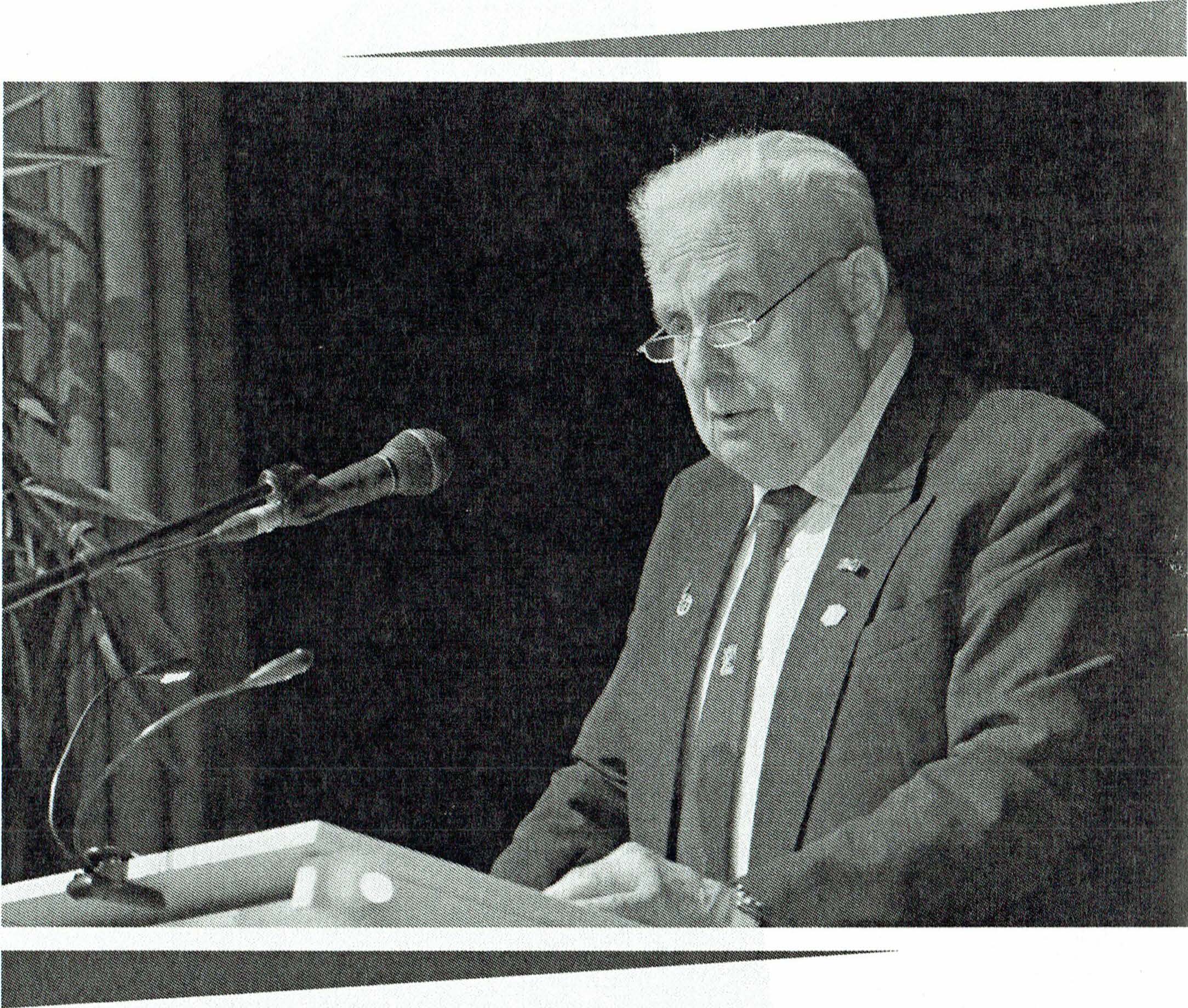
Tanno Pieterse during his speech for the Arnhem Veterans Club on 27 September 201 7. [Photo: berrydereusfotografie.nl]
SATURDAY I+ JULY 2015: BATTLEFIELD TOUR TO THE ALBERT CANAL AND FORT EBEN- EMAEL IN BELGIUM
This year, it is 75 years ago that one of the most spectacular actions of WW2 took place.With the introduction of a new type of military force, na mely paratroops and gliders, and a new weapon, the hollow charge, on 10 May 1 940, in just 15 minutes, German forces overran the strongest fort in the world, Fort Eben Emael in Belgium. The German introduction in 1 940 of paratroops and gliders, g ave an example, which led to both England and America, following suit in establishing paratroop units. The efforts of the Allies, resulted four years later, with the deployment of parachute divisions in Normandy and the Netherlands.
The SFAM is organising on Saturday 4 July, in conjunction with the Dutch ‘Documentation Group 40-45’ and ‘ Battlefield Tours Groningen· , a one-off Battlefield tour to the Information Centre ‘The Bridge· at the Albert Canal in B elgium and to the nearby Fort Eben- Emael.
The recently opened information centre gives a picture of the defence in 1 940 of the bridges over the Albert Canal and the role played by the Fort Eben- Emael. The visit to Fort Eben Emael will be led by a Dutch speaking guide.
Cost€50,-, should be transferred to account No: IBAN NL33 I NGB 0005 1 1 37 51 in the name of Vrienden van het Airbornemuseum, Oosterbeek, with description BFT 4 Ju ly. Your payment is also your registration. See the WAM website for further details of the tour.
PARTS OF A EUREKA BEACON BOUGHT BY THE SFAM AND DONATED TO THE AIRBORNE MUSEUM
Shortly befo re the main land ings near Arnhem, 1 86 troops from the 21 51 Independ ent Parachute Company, under command of Major Bernard Alexander (Boy] Wi lson were d rop ped. These ‘ Pathf inders·, had the task to mark the d ropping and landing zones. This, the men did with the help of marking panels, smoke si gnals and Eureka rad io beacons. Through use of Rebecca installations within the ai rcraft bringing the main forces, they were able to locate the correct drop ping and landing zones.
The Eureka beacons were equipped with an explosive device and thus, if there was a chance that the enemy could capture the item, it could be blown up. Thus it is very rare to find a complete example of this installa tion. There is a story that during the Battle of A rnhem, the Germans captured one Eureka set and that as a result, resupp ly d rops fell into German hands, but this is just untrue. From reports it is clear that, during the fighting, two of the presumed 48 Eureka sets were destroyed and that not one fell into German hands’
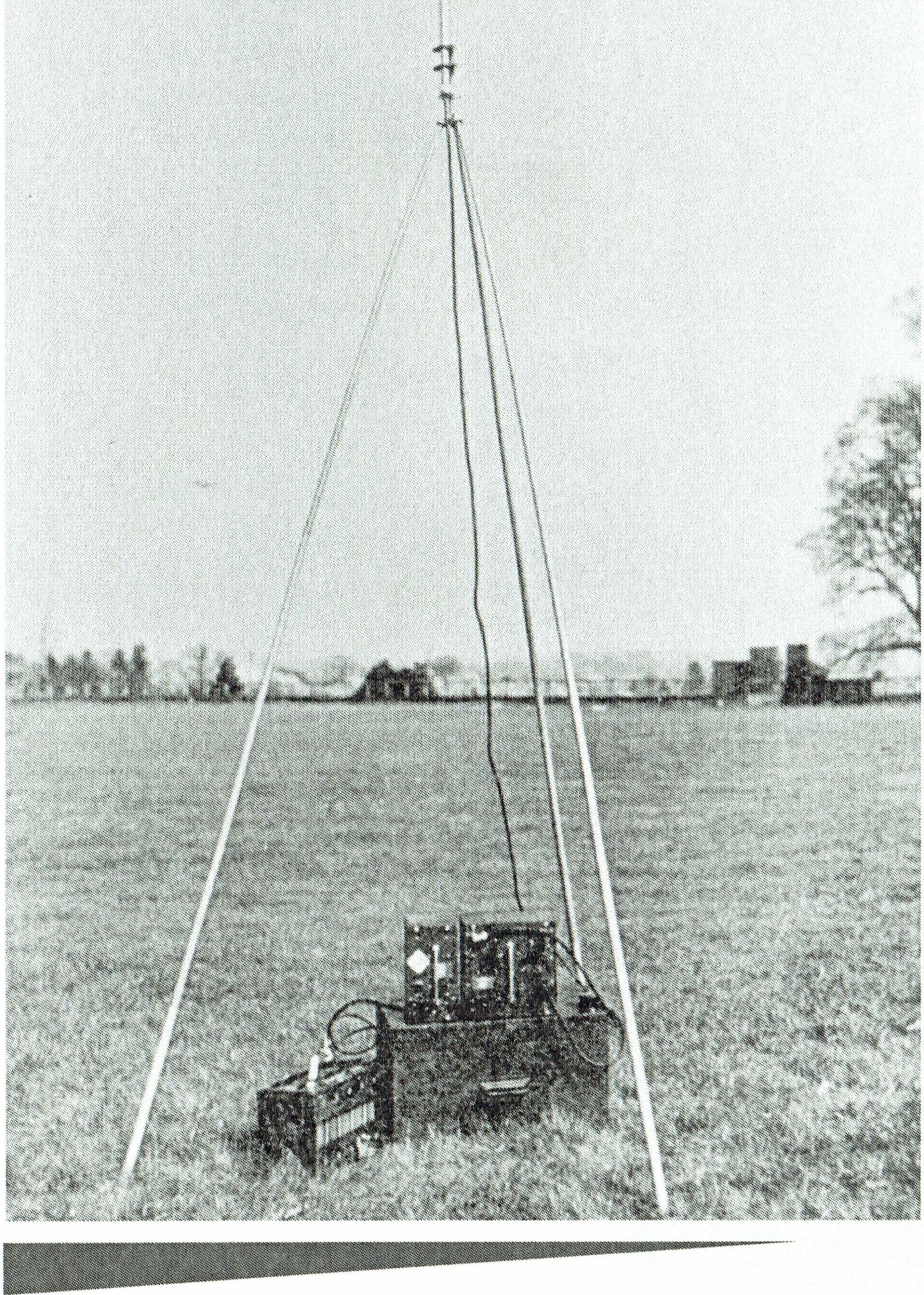
Eureka beacon with aenal (Photo: Wybo Boersma collection)
In 2008, the Ai rborne Museum was able to obtain a Eureka Mk 11 beacon set, but it was not a comp lete installation. Recently, the Museum, with financial sup port from the S FAM, has managed to obtain a power supp ly unit with e lectrical converter. This now stands in the disp lay cabinet next to the model of a British parachutist. Still missing are the aerial, the main telephone, the 24-volt battery and the connecti ng cables, but perhaps in the future these can also be found.
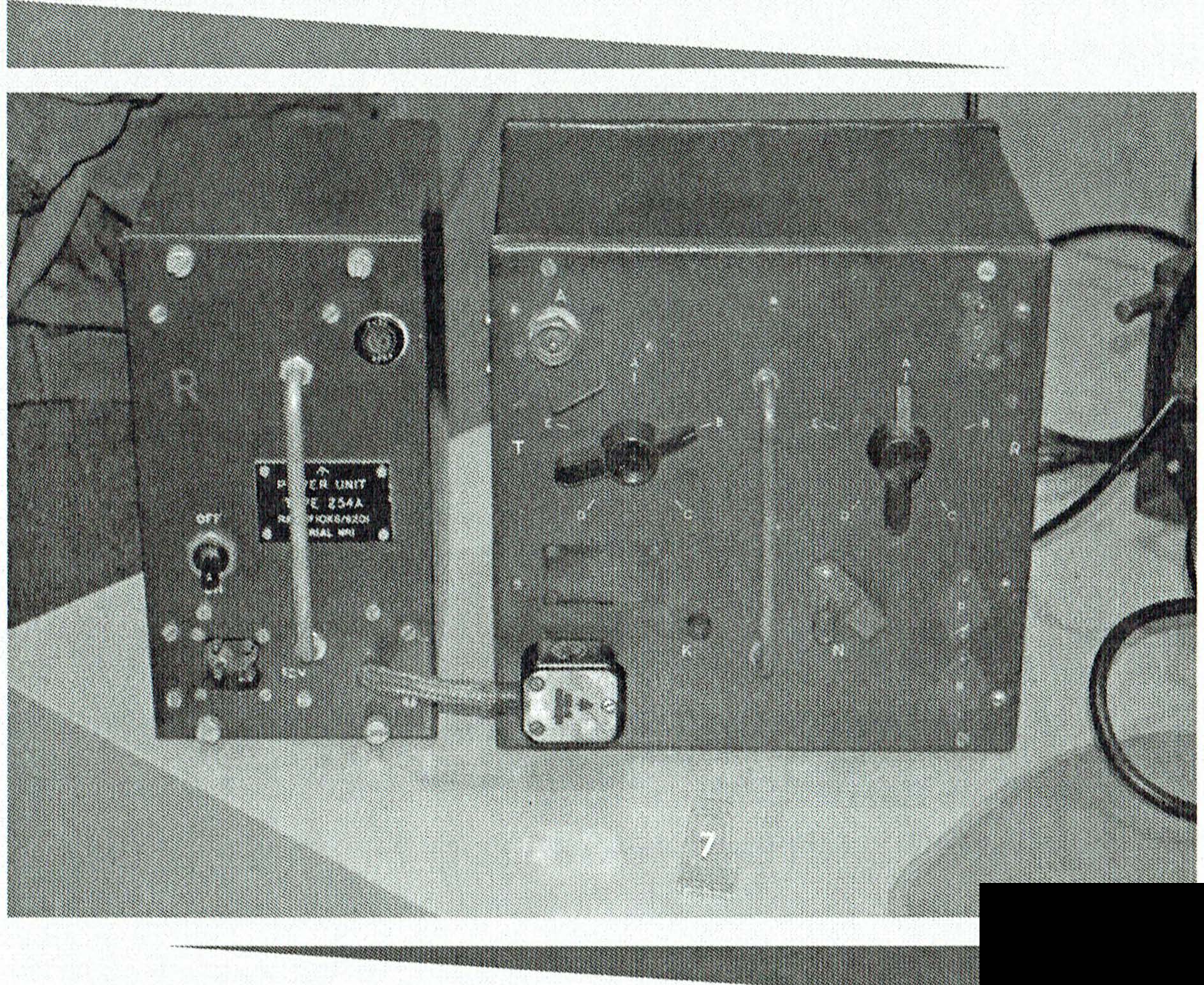
The Eureka beacon in the Airborne Museum. To the left, the supply unit purchased with support from the SFAM (Photo: Roland Boekhorst)
SPEAKERS INVITED
Every year, the SFA M o rganises in November or December, a lecture about a subject connected to the Battle of A rnhem and, during the last 34 years, very many subjects have been offered. On 14 November this year, there is again an afternoon lecture planned .
We know that various members of the SFAM invo lve themselves in vari ous aspects of the Battle of Arnhem. This year, we would like to invite a number of them to giving a sho rt p resentation, about the subject they are most closely involved in. If you would be interested in giving such a short [ 20 mins or longer] p resentation, possibly with the suppo rt of Power Point, then p lease let us know before 1 st July 2015 via: info@vriendenairbornemuseum.nl
WHO CAN DESIGN A LOGO FOR THE SFAM ?
The Society of Friends of the Airborne Museum, feels a need for a logo. We already use a type of letter heading, which includes an image of the Museum and a glider, but that is less suited for, say, advertisements. The Airborne Museum uses thePegasus emblem in their logo, so we cannot use it again. Which creative soul will desig n something appropriate for us to use?
For the desig ner of the win ning d esig n will be a gift voucher for€25 available, to be used in the Museum shop. You can send desig ns to the SFAM at Vereniging Vrienden van het Airborne Museum,Post Box 8047, 6710 M, Ede, NL or by e-mail to info@vrienden airbornemuseum. nl. Reception of designs will close on 1 st July 2015.
BOOK ABOUT THE DENISON SMOCK
Recently in the UK, a book was published d ealing with the Denison Smock, also popularly kn own as the para smock. It is a specialist book about a well-known uniform item, that, d uringWW2 was worn by British paratroops and also by other units and that is still in use today. Also in various other countries, the Airborne sm ock was worn and has been copied . It shows that the origin of the Denison smock lies with the German ‘Knockensak’, an apparel item that , during WW2 , was used by the German parachutists.
The first British smocks were an exact copy of the German item. But , quickly, the British smock was developed in its own s pecial form. It was a practical piece of clothing that, during the War, was not on ly wor n by paratroops, but also by, amongst others, Commandos and snipers . Also, d uring the Dutch military operations in the former Netherlands East Indies between 1 945 and 1 949 , British smocks were used. Because in a short time, many smocks were n eeded to be supplied, sm ocks had to come from different factories and so metimes had a slightly d ifferent finish, in as well as the model, but also the camouflage pattern. Bruce Wilson has studied the collections both in museums and in
private collections and has attempted to bring some order to the total. Nearly all photos are in colour and of a high quality. For those interested in the history of the British Airborne Forces and the uniforms wor n by them, it is an excellent and attractive reference book.
‘ Denison · by Bruce Wilson ISB N 978- 1 -62620- 1 84-2 published by Military ModePublishing 20 13, 203 pages, illustrated with colour pictures, Eng lish text.
Price€45 . In Holland the book is available to buy at the Airborne Museum [ Wybo Boersma]
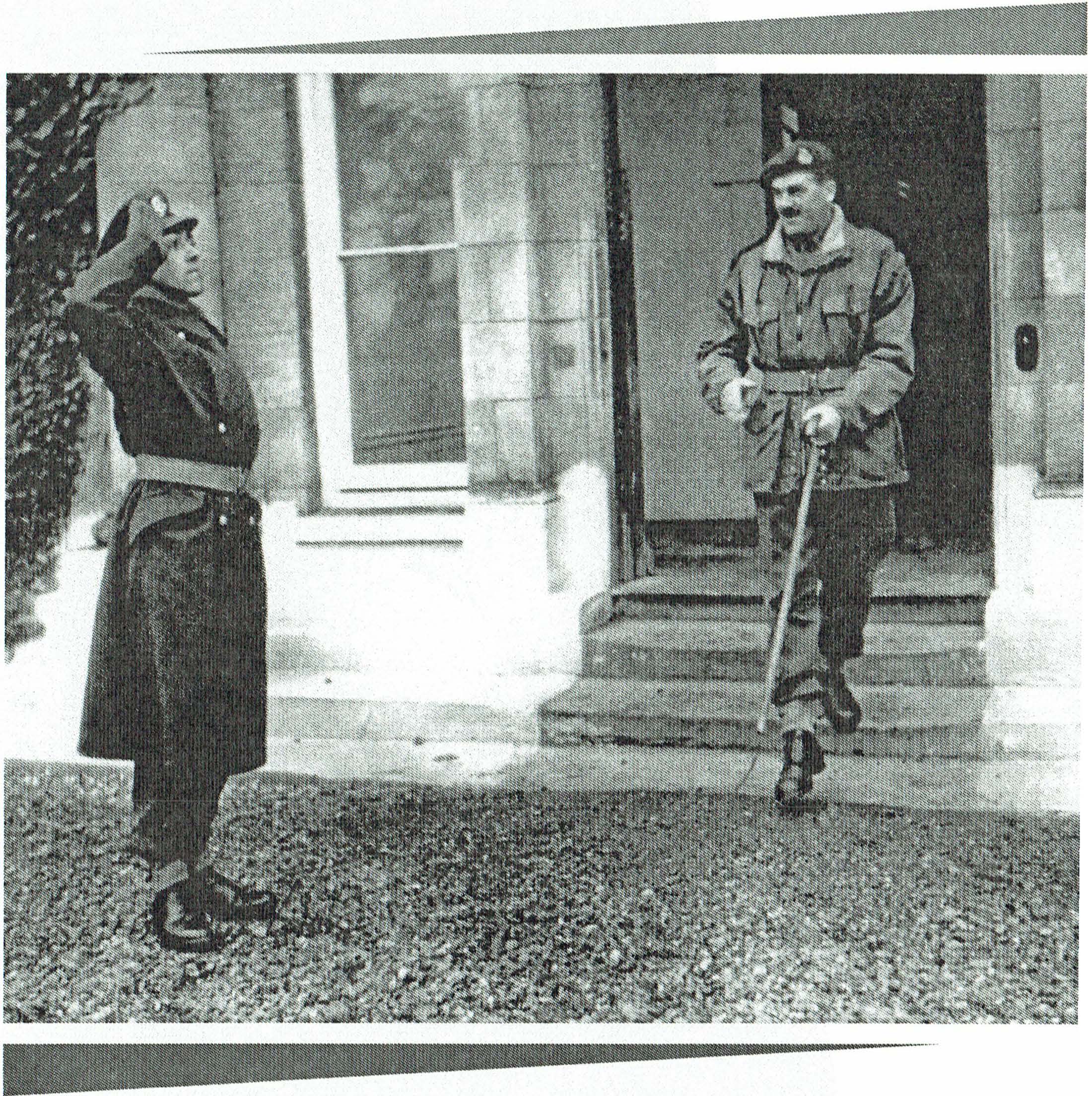
One of the smocks that does not appear in Wilson s book, is that from MaJ Gen Urquhart, that 1s now displayed ,n the Airborne Museum in Oosterbeek. In this photo, General Urquhart is wearing this smock, which model differs from the standard model. The photo, in which Lance Corporal J Tof1eld salutes General Urquhart, was taken 1n December 1 944, at Fullbeck Hall in Lincolnshire. (Photo: Airborne Museum collection)
EXHIBITION – VAN HUIS EN HAARD – AIRBORNE MEMORIES”, EXTENDED DUE TO ITS SUCCESS.
The temporary exhibition Van Huis en Haard – Air borne Memories· [‘ From House and Home – Airborne Memories’] in the Airborne Museum has been ex tended until 20 16. The exhibition, that tells the story of the evacuation from Arnhem and surroundings in September 1 944, received praiseworthy reactions from the public.
Impressive, moving and emotional. Just a few of the reactions from the public after a visit to the exhibition. This largely unknown section of the war history, brings much out of visitors. Children ask their grandparents, how they experienced and coped with their return to a largely damaged or destroyed city. British visitors are astounded and touched by the citizens stories during and after the Battle of Arnhem. More than 86,000 people visited Van Huis en Haard – Airborne Memo ries·, since its opening on 25 April 20 1 4. [Tessa Jansen]
Visitors were touched by, what for them was often unknown, stories about the citizens evacuation after the Battle of Arnhem.
MINISTORY 121 The Royal Air Force ‘Air Liaison Group· at Arnhem
By Wybo Boersma
During the Battle of Arnhem, as well as parachutist and air-landing battalions within the British 1 st Airborne Division, other units were attached. Much is known about the larger units such as the Royal Artillery, the Royal Engineers, the Royal Army Medical Corps and many others. With the passage of time, many stu- dies have taken place about almost all of these units. However, there were also many smaller units, about which often much less is known. The reason is that little or nothing about their history has been retained. That was because, often, no ‘After Action· reports were completed. In most written accounts, they are often only sporadically referred to. Many of these units, after the War or even sometimes shortly after the Battle of Arnhem, were wound up and surviving participants can no longer be traced.
One of these less known units is the Royal Air Force Air Liaison Group, comprising the LightWarning Set Units No: 6080 and No. 6341 , two radar units. During the planning, it was thought that, after the landings, the Airborne troops would provide an easy target for the German night bombing force. Therefore, the HQ staff made plans to construct a 1 000 metre runway for Beaufighter night -fighters near Nijmegen. To pro vide tactical guidance for these night-fighters, a RAF Ground Controlled Interception [GCI] radar station was needed. It was decided that two mobile radar stati ons with 24 RAF personnel, would be carried, divided between four gliders and would land in the Nijmegen area, in the hope that at least one complete radar station would come into being.
As early as 1 941, personnel at the Telecommuni cations Research Establishment [T RE] started the development of a mobile radar station, with a range of 50 miles. In March 1 942, radar installations, Light War ning Sets, were developed, that could be carried and fit in a 3 ton lorry or a 15cw military vehicle. As a result, about 2000 sets were built in England and America and were used in the Middle- East. North Africa and Normandy. In consultation with the Air Ministry, there were also Light Warning [ LW U] and Ground Control ler Interception [ GCI] sets built, that could be carried in gliders. Two LWU and one GCI sets with necessary personnel were attached to 38 Group RAF and moved to the Headquarters of the 1 st Airborne Corps . The per sonnel attached consisted of supervisors, technicians and operators. These all came from the RAF. The two units, LWU No: 6080 and LW U No: 6341 were eventu ally utilised for Operation Market Garden.
AMES Type 6 Light Warning Set
AMES stands for Air Ministry Experimental Station, the code name for a radar station. Although not exactly known which type of radar unit eventually went to Arn hem, the body of opinion is that it was the AM ES Type 6 Light Warning Set. Just one source speaks about the American supply of this set, the AN/PTS-3 but that it unlikely as all the personnel were British. The AMES Type 6 comprised a t ransmitter and a receiver, a Plan Position Indicator [PP!]. a Ya gi [TV type) aerial and a tent, in which the insta llation cou ld be constructed. In addition, thought was given to the use of a diesel generator and the necessa ry maintenance kits and spare parts. The whole thing was packed in 16 large us and heavy crates. The range was 50 miles distance and a height of 3000 met res. A number of these units have been p reserved. The Air Force Museu m in Linkoping, Sweden, has more or less three comp lete radar sets. Of these, one has been very recently rebui lt. However, these radar sets were built under licence in America in 1944 and on the inner wall a re marked Signals· .
During the War, eleven units were swapped for a V1 roc ket, that had accidently landed in Sweden. The
Airborne Museu m in Oosterbeek has one AM ES Type 6 unit on loan. This one is not complete. A number of missing parts were supplied by the Ai r Force Museum in Linkoping.
The use at Arnhem
During discussions on 15 September 1 944, at Bentley Pri ory [the headqua rters of RAF Fighter Command in NW London) those present were of the opinion that no radar unit was necessary for Operation Market Gar den. This was a major disappoi ntment to the mi lita ry personnel of the LW units. The fo llowi ng day, the deci sion was reversed by General B rown ing, possib ly un der the influence of Wing Commander John Lawrence Brown MBE. From 1 941 , B rown was closely involved in the use of Ground Controlled Interception [GCI). He took part in the landings in North Africa, as well as at Sici ly, Ita ly and Normandy, in the post of Commanding Officer and Senior Controller of mobile GCI stations. Brown was Commanding Officer of the radar units that would land at Arnhem.
Staff Sergeant Edwards, a glider pi lot from A Squa d ron, the Glider Pi lot Regiment, recalls that, on 15 September he was instructed that his original o rder to depa rt with a jeep and a 75mm Howitzer on 17 Septem ber 1 944, had n ow been changed and that he would now take off on 1 8th September with a radar un it. After the fi rst lift had left for Arn hem on the 1 7th September, the crews of four g lide rs were called to at tend a meeting in the briefing room at Harwell. There they heard the announcement that a landing strip was to be la id east of N ijmegen for Beaufighter night fighters. For this function, the establishment of a radar function was necessary. The location near N ijmegen was later that day altered to the Landing Zone “X” at Wolfheze. On the thi rd day of Ope ration Market, the 878th [US) Aviation Engineering Battalion, with 80 Ame rican and 10 British gliders, was to land at Wolfheze,
to lay out an ai rstri p. The British engineers had taken a 82 bu lldozer to help c lea r the earlier landed gliders from the site. There were to be two Light Warning
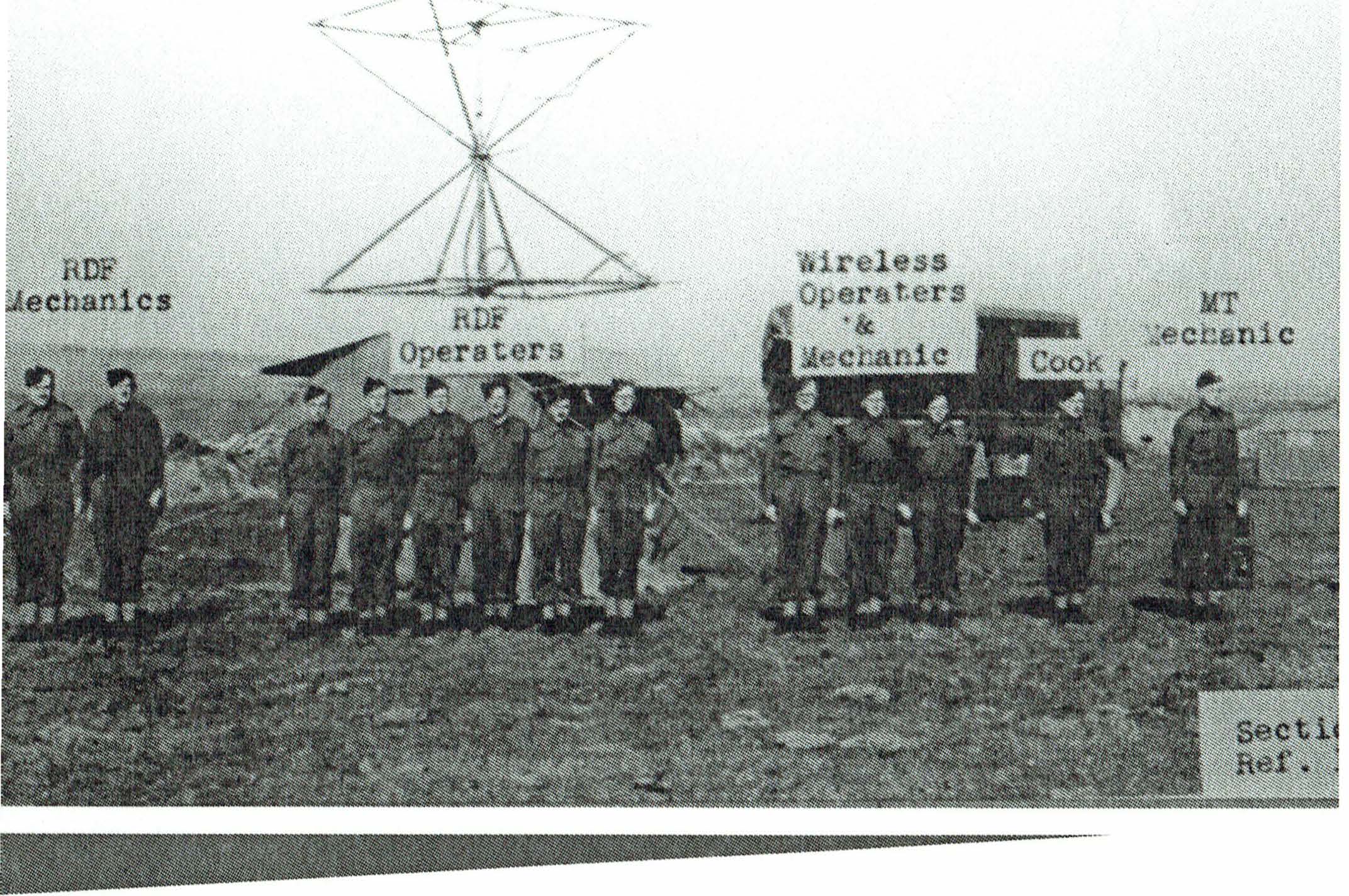
Personnel of a Light Warning Urnt (Sdn Ldr F Hayward archive)
Units flown in, the parts of which were each to be divided between two gliders. Troops were to be given extra radios to enable them to contact all concerned, in the event that the gliders could not land where intended. Because the radar role was a static one, no transpo rt faci lities were included. How men were supposed to move the 16 la rge c rates with an extra generato r. fuel, wa ter, tents and radios was a mystery. What was also unknown, was how the remaining material and equipment for the Beaufighters was to reach the Netherlands? One of the glider pilots, John Kennedy, commented that to him the whole plan seemed to have been “put together in a hurry” .
Each LWU came under command of a Squad ron Leader, with a Flight Controller, an NCO and a number of other ranks. The whole unit was commanded by Wing Com mander Brown. There wou ld also be two Ame rican officers, from No.306 Fighter Control Squad ron in France, who would go as GCI Controlle rs, but at the last moment, that was d ropped. Even so, one did join the task, as a voluntee r. There is an After Action Report known, which came from him. The RAF t roops had not had mi lita ry training. On 17 September 1 944, they fi rst went for an hour to the firing ra nge, to receive a bit of training in the use of weapons and hand g renades. Each fi red off a full Stengun magazine and a rifle and tossed both a hand-grenade and a smoke g renade. The weapons we re loaned from the arms store, but were not returned the re! Two RAF troops were armed with a Stengun, the others with a Lee-Enfield rifle.
The Landing
Wing Commander B rown flew with the fi rst lift to Groesbeek with Browning’s Headquarters. He was killed on the landing zone, when that was fired on by some Me 1 09 aircraft. Brown lies buried in the military cemetery in Groesbeek.
LightWarning Unit No.6080 comprised 9 men, under command of Squadron Leader Coxon. They were car ried in two Horsas. American Lieutenant Davis flew with them.
Horsa Chalk Number 5000, was towed by a Stirling which was hit by AA fire. It crashed at Opheusden. The whole crew died. As a result, its glider made an emergency landing at Hemmen in the Betuwe. After the landing, they made the apparatus unusable. In that same area, two other gliders landed, carrying South Staffords and some jeeps, motorbikes and one 6-pounder gun. There they joined forces with each other. With help from local residents, they moved to the Oriel ferry. The ferryman was not sure if he should charge them for the crossing ‘ On reaching the nor thern side of the Rhine, the RAF group tried to make contact with the British pt Airborne Division HO. On reaching the railway bridge at Oosterbeek- Laag , they came under enemy fire, took cover and the group lost contact with each other. The next day, the American Lieutenant Davis, took them to the Divisional HQ in
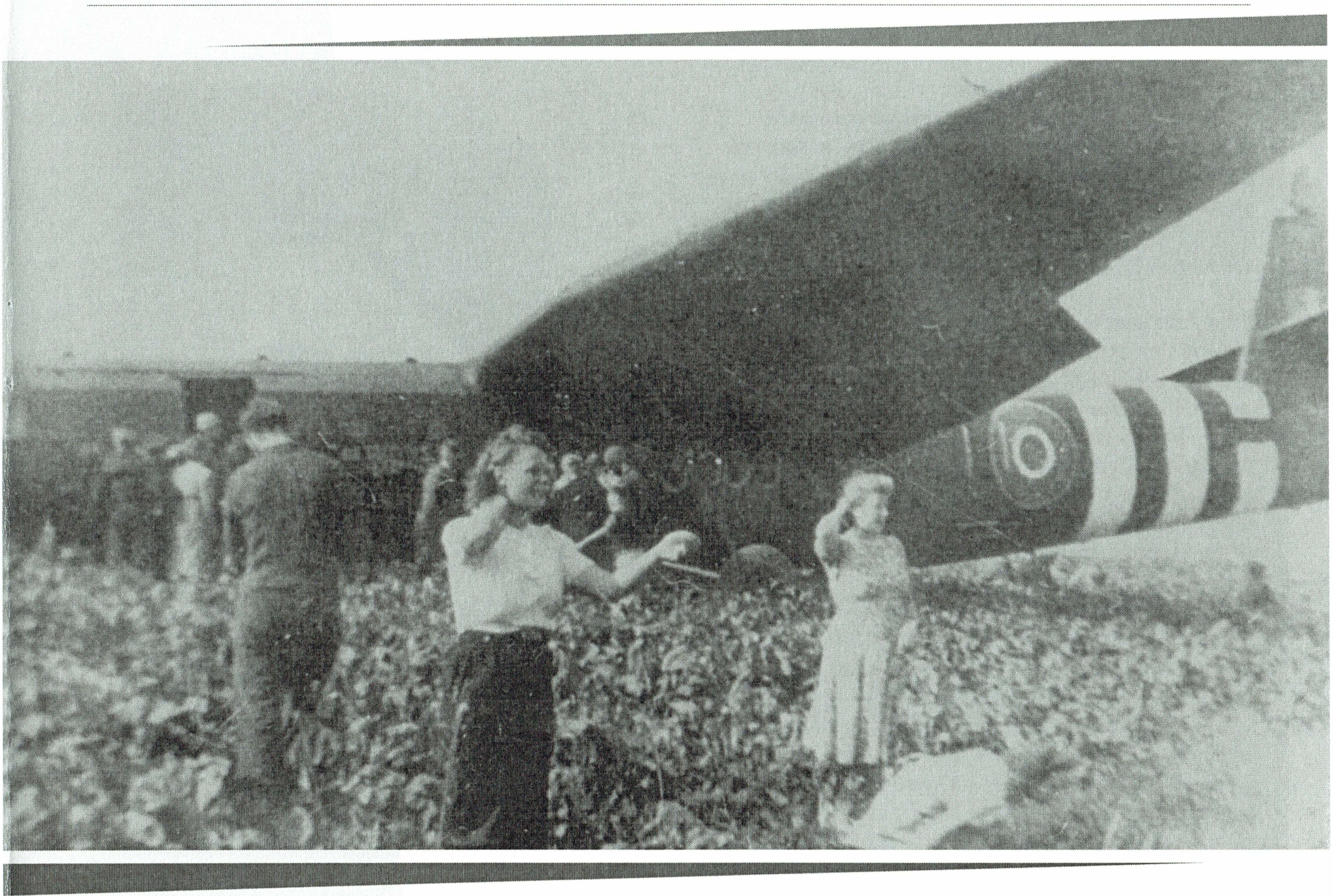
Glider Chalk number 5000, af/er the emergency landing at Hemmen, in the Beluwe region. (Photo collection – Zwijnen-Reijmen)
Hotel Hartenstein.
The second Horsa, Chalk Number 5002, landed on the landing zone undamaged, but was then shot at by Germans and caught fire. Thus this equipment set was also lost.
Light Warning Unit No: 6341 , consisting of 14 men, under command of Squadron Leader Wheeler was also split between two Horsas. The first Horsa, Chalk Number 5003, on approaching the Landing Zone was shot at and the tail was detached, after which the glider crashed at Doodewaard. The whole crew and passengers were killed. They received a fi eld grave beside the remains of the glider. The last Horsa, Chalk Number 5001 , landed safely on the landing zone but , as only one of the two gliders arrived, carrying only one transmitter, a large aerial, one diesel generator, diesel, one radio, spare parts and water, the apparatus was incomplete. The troops destroyed the transmitter with axes and everything relating to it and blew the rest up. The two gliders that did arrive safely in Arnhem had the same load so that it was impossible to construct a complete radar post. So ended the intended use of the Light Warning Units at Arnhem in a total failure.
The fortunes of the personnel
What happened to the RAF personnel during the passage of the fighting? Because as RAF personnel they had not received any infant ry training, as far as is known, they were not further deployed. Some detai ls about their experiences during the Battle of Arn hem, a re known by reports and letters.
Squadron Leader Richardson was seen in the area a round Hartenstein with some RAF personnel. He was dressed in milita ry uniform with a flat cap and thus not regarded as equipped for a fight.
Airman Eric Samwells possibly se rved as a stretcher bearer. He was killed on 22 September 1 944. His field grave was at a field at the Hoge Oorsprong, to the west of Van Borsselenweg in Oosterbeek.
Airma n Austin wrote a report of his experiences. After he was in an eme rgency landing at Hemmen, he cros sed the Rhine at the Driel ferry. In the a rea of the rai l way bridge at Oosterbeek- Laag, he met the American Lieutenant Davis. Davis brought Austin and a number of other RAF personnel to Park Hartenstein on 19th Septembe r, gave them a few shovels and left them to dig some foxholes. This was appa rently something new for the RAF men, but according to Davis, that was their life saving. Austin made a foxhole with Eden, a RAF radio tech nician. Eden was later asked to help an America n Air Support Team with repai rs to their radios. During a mortar attack, Eden was killed. On 20 Septembe r, Austin was wounded by mortar fi re. Pro bab ly he was taken to the Tafelbe rg. Eventua lly he was t ransferred to the Germans and thus ended as a POW. The re he stayed until April 1 945 in Stalag X1 B at Fal lingbostel. There, according to his sto ry, he was freed by the Russians. That is not true as the camp was in fact liberated by the British. He then flew by Dakota to Brussels and subsequent ly back to England.
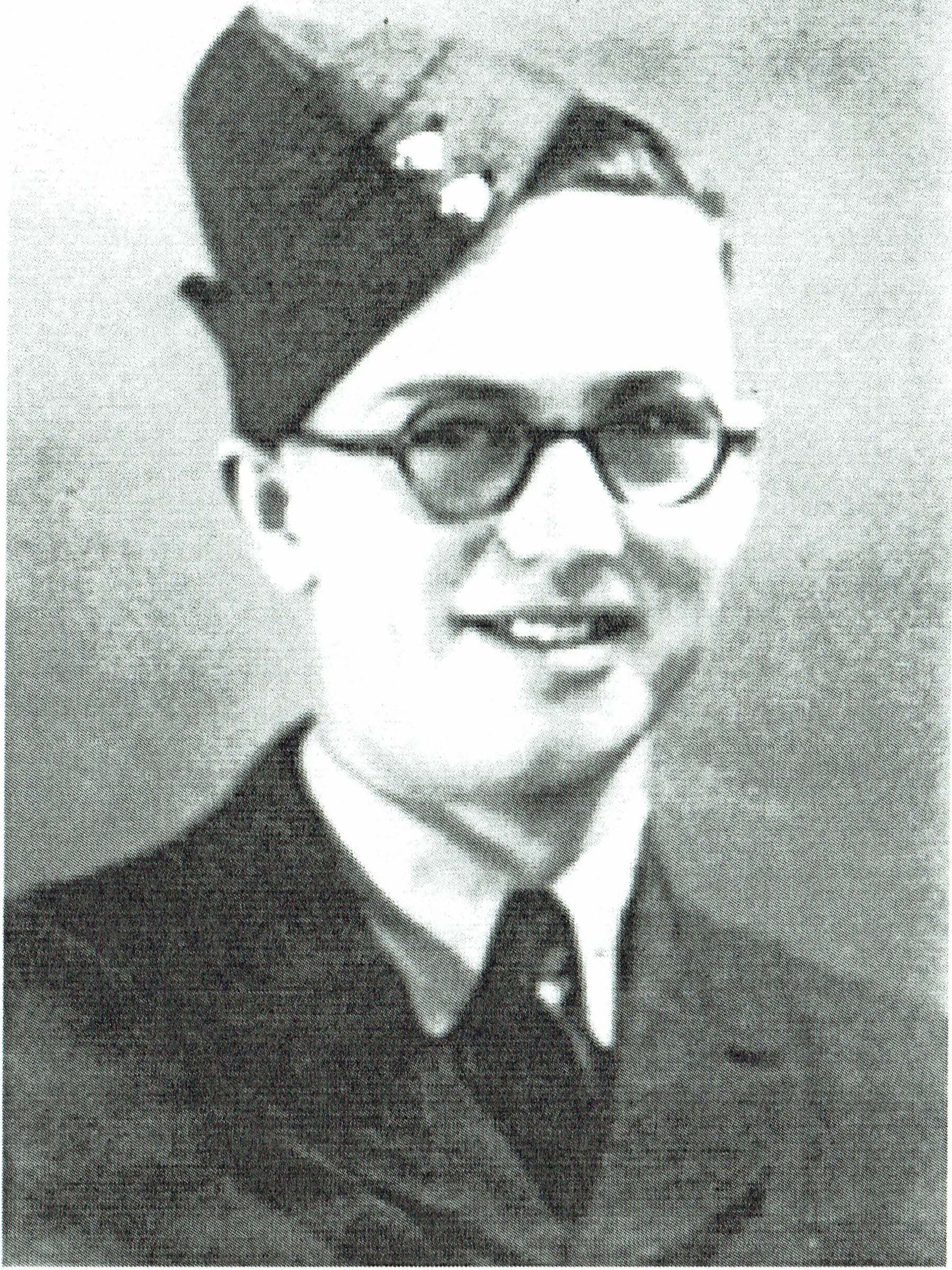
Corporal Eric A .Samwells, RAF, 21 years old. Died on 22 September 1944. Buried at the Arnhem- Oosterbeek War Cemetery, Grave No: 4. C. 20 (Photo from Samwells family)
Of the 24 RAF military personnel, 1 0 died, of whom one at Nijmegen [Wing Commander B rown ), 1 1 were made POW and 3 escaped. The escapees were all officers. Of one man, it is unknown if he was taken prisoner and then died? Va rious sources repo rt that the unit consi sted of 25 RAF personnel, in which case 4 men would have escaped from Arnhem.
For this a rticle, amongst others, reference has been made from the following sources:
RAF radar in Arnhem, 1 8th-25th September 1 944 by Sdn Ldr Frank Haywa rd – 21 Ma rch 1 944 [not published]
Tugs and Gliders to Arn hem by Arie-Jan va n Hees [Private pu blication]
Report on Arnhem Operation 1 8-25 September 1 944 by Lt Bruce Davis 1 st Lt USAF
Report by Staff Se rgeant Edams, Glider Pi lot
Report by Staff Sergeant John Kennedy, G lider Pi lot
Report by Corporal Albert Austin RAF.
Pegasus, April 1 980, Magazine of the Parachute Regiment I EE. Proceedi ngs, Vo l 1 32 Pt. A No. 6 October 1 985.
Signals Vol.4, Radar in Raid Reporting, Air Ministry 1 950
Ministory No: 44 with N ewsletter No.56 N ovember 1 994 from the SFAM by L. Buist.jr Air Force Museum Archive in Linkoping, Sweden
PROGRAMME FOR 2015
13 – 17 May: Battlefield Tour Normandy. Excursion by coach to the battlefields in Normandy. Tourguides will be from the International Guild of Battlefield Guides and from the SFAM.
30 and 31 May: Weekend of the Wa r Book’ around and in the Airborne Museum Hartenstein in Oosterbeek.
Saturday 30 May: Sale of second-hand books, about WW2. Location: The grounds of the Airborne Museum, Hartenstein. Opening: 09.30h r.
Saturday afternoon 30 May: Walking tour in Oosterbeek: ‘The Battle of Arn hem from the German side’. The guide will be Ingrid Maan. Start at
13 .30 hrs, at the Airborne Museum
Sunday afternoon 31 May: Lectures by Ingrid D. Jacobs and Joost Roosendaal in the Museum around the theme ·war book’.
26 – 28 June: ‘UK Weekend’ in Oosterbeek for UK members of the S FAM.
Saturday 4 July: Battlefield Tourabout the German Ai rborne attack on 10 May 1 940 on the Fortress Eben Emael in Belgium.
Saturday 12 September: Battlefield Tour’Traces of the Battle of Arnhem·. Day- tour by bus over the battlefields at Arnhem/Oosterbeek and surroundings.
1- 4 October: Battlefield tour ‘Battle of the Ardennes· . Four days bus excursion. Actions of the 10 1 and 82 US Airborne Divisions and the Battlegroup Peiper during the Battle of the Ardennes.
Saturday 14 November: Lecture in the Concert Hall in Oosterbeek Laag – Subject content wi ll be announced later.
Further details and supplements to the p rog ram will be released as soon as possible via the website or via the Airborne Magazine.
See: www.vriendenairbornemuseum.nl
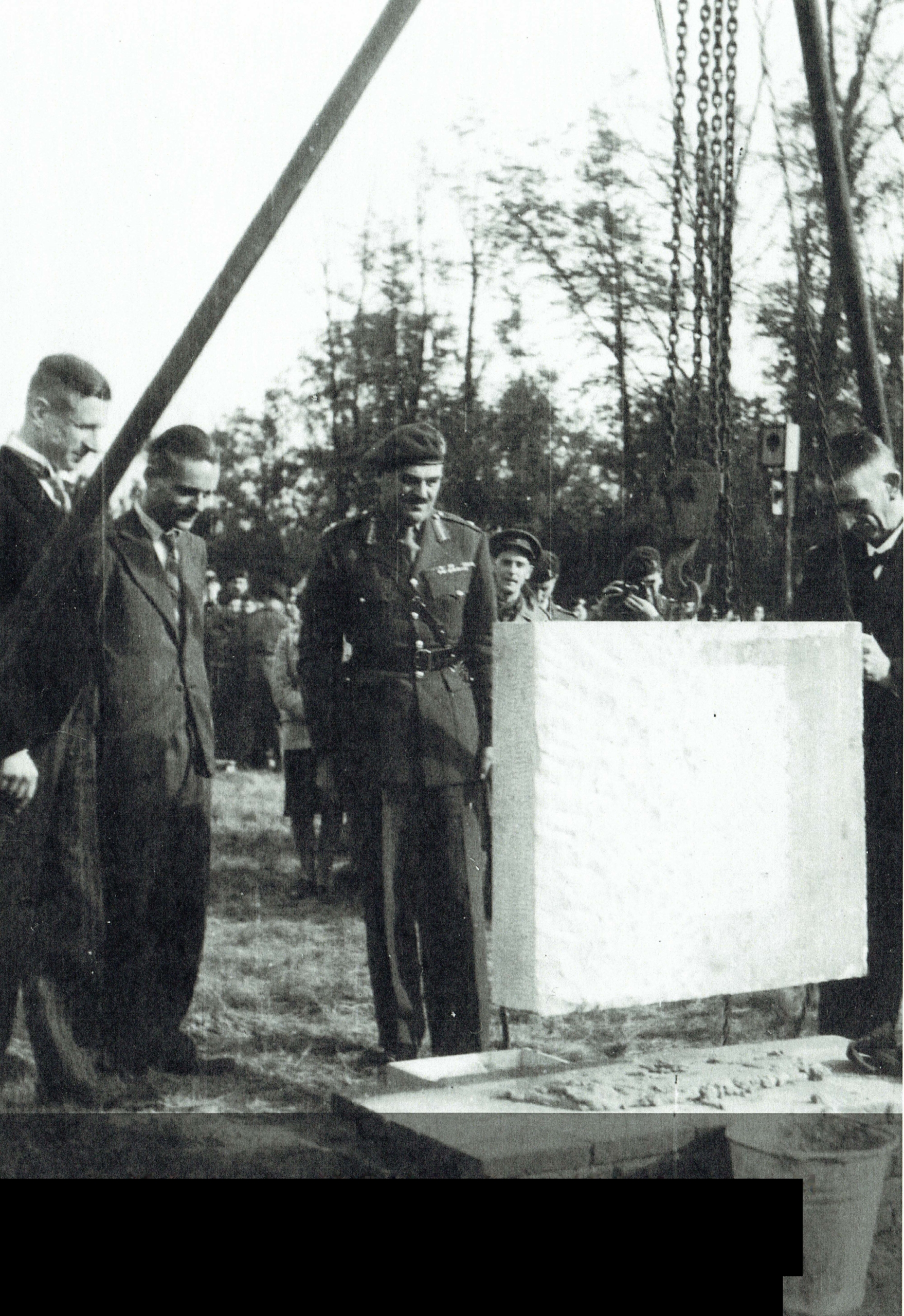
On 25 September 1 945, Major-General R. E. U rquha rt la id the fi rst stone for the Airborne Monument, opposite · Hotel Hartenstein in Oosterbeek
(Photo : B.H. Langevoort]
COLOPHON
The Airborne Magazine is a publication of the Society of Friends of the Airborne Museum Oosterbeek [SFAM) and appears three times per year. The objective is to promote the Airborne Museum, the SFAM and the history of the Battle of Arnhem.
Editors: Drs. Robert P.G.A. Voskuil, Wybo Boersma MBE,Tessa Janssen [Marketing @ Sales Airborne Museum), Marieke Helsen, Curator of the Airborne Museum.
Archiving and distribution of back numbers of the magazine: Wybo Boersma, Ede, w.boersma@wxs.nl
Translation: Peter Burton, London, UK
Design: Michal Kuscielek Artefakt Design, Nuenen
Print: Wedding Proson, Harderwijk
E-mail address SFAM: info@vriendenairbornemuseum.nl, Telephone: 0318 639633
Postal address: SFAM, lvar Goedings,
P.O. Box. 8047, 6710 AA, Ede, The Netherlands
Download the magazine in pdf format
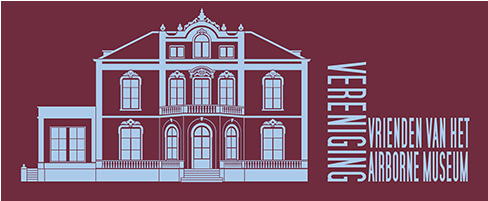
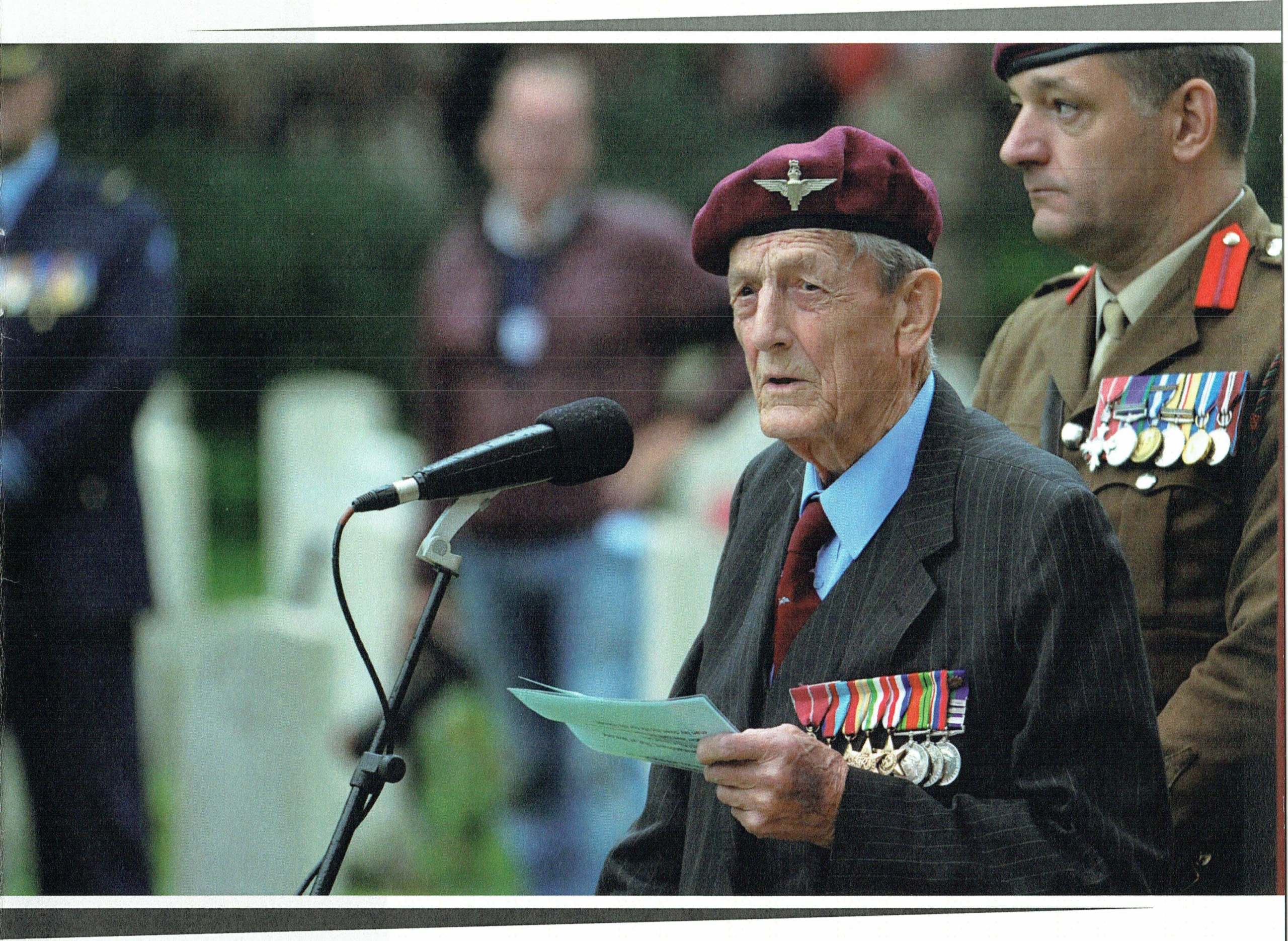


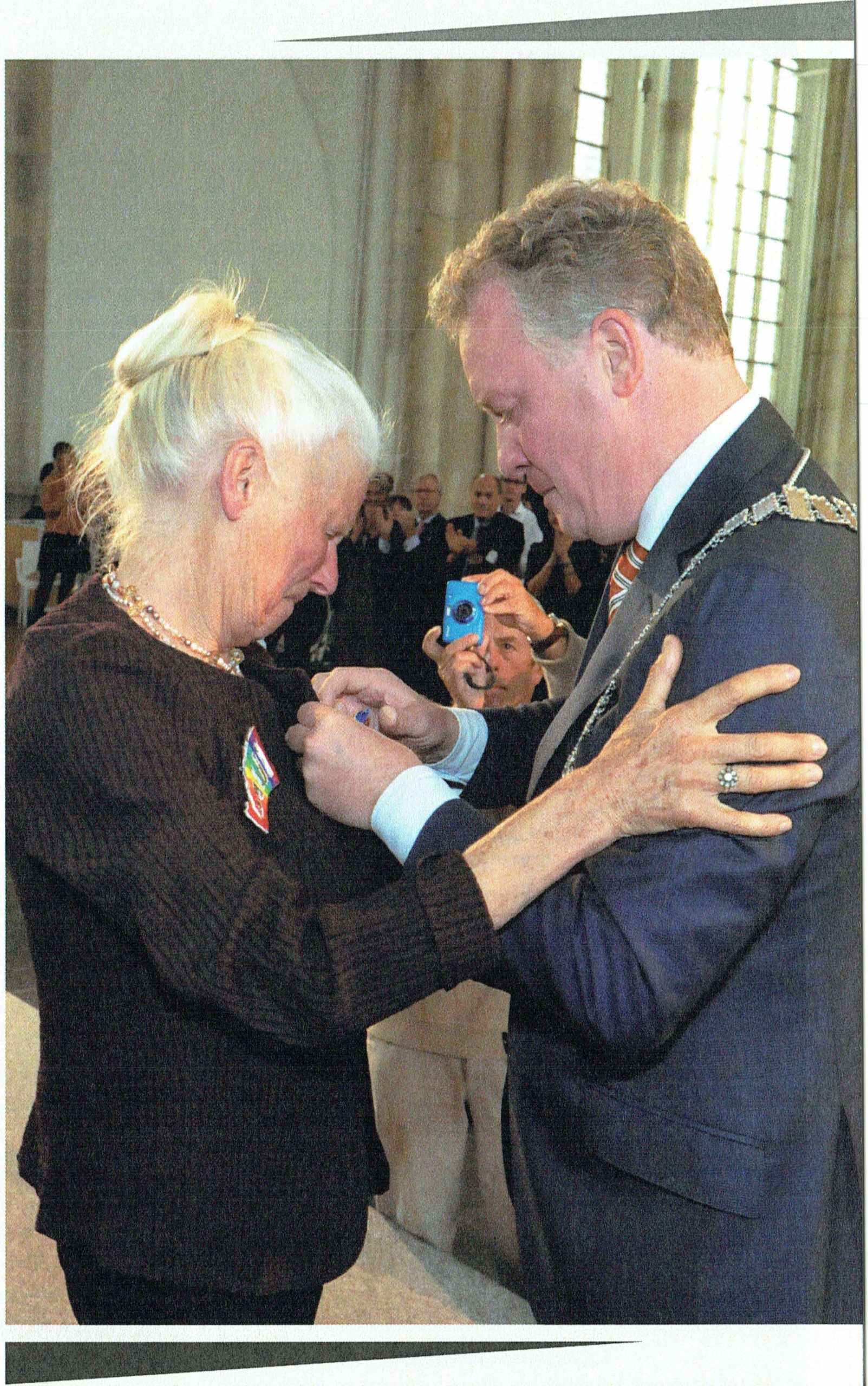
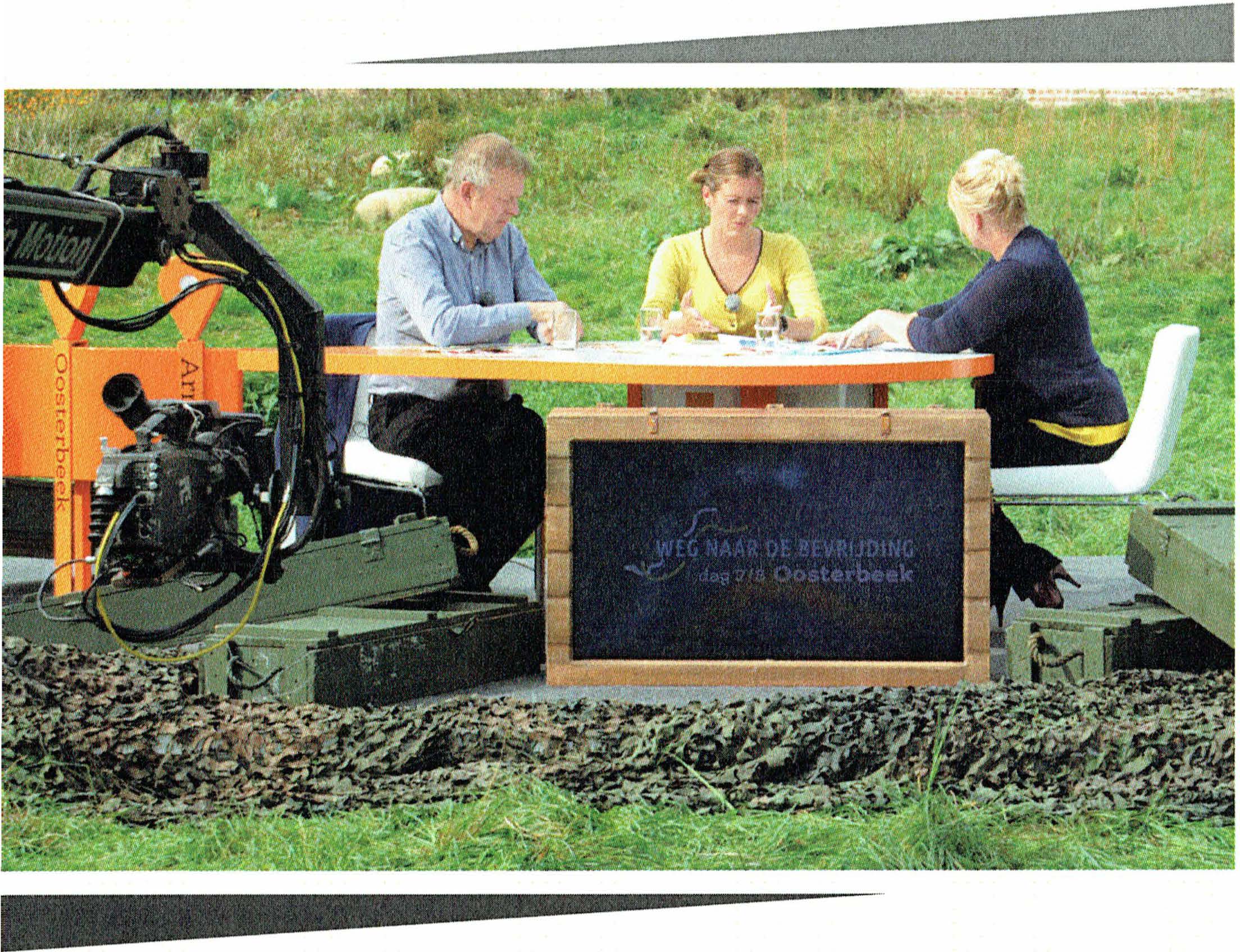


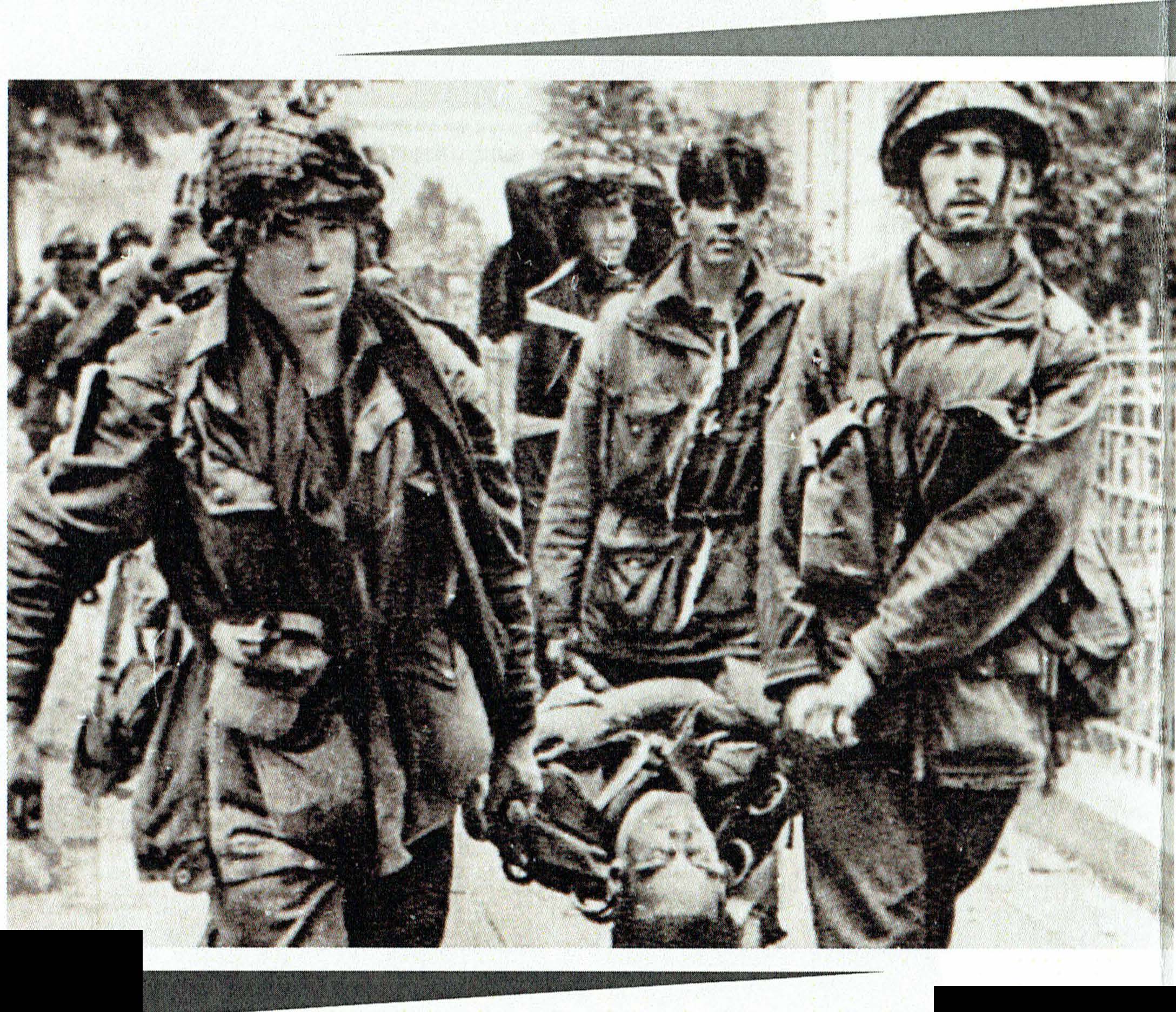
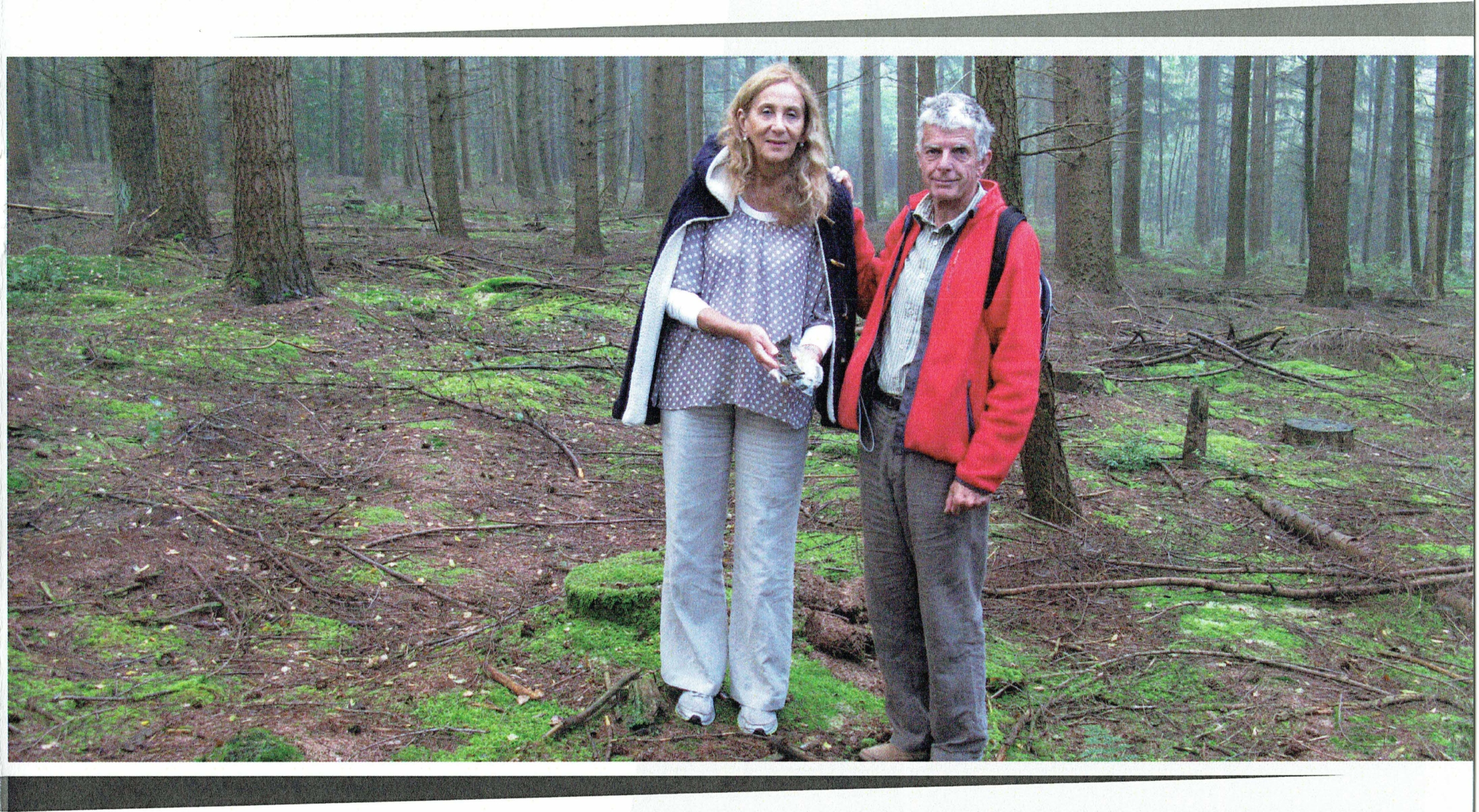
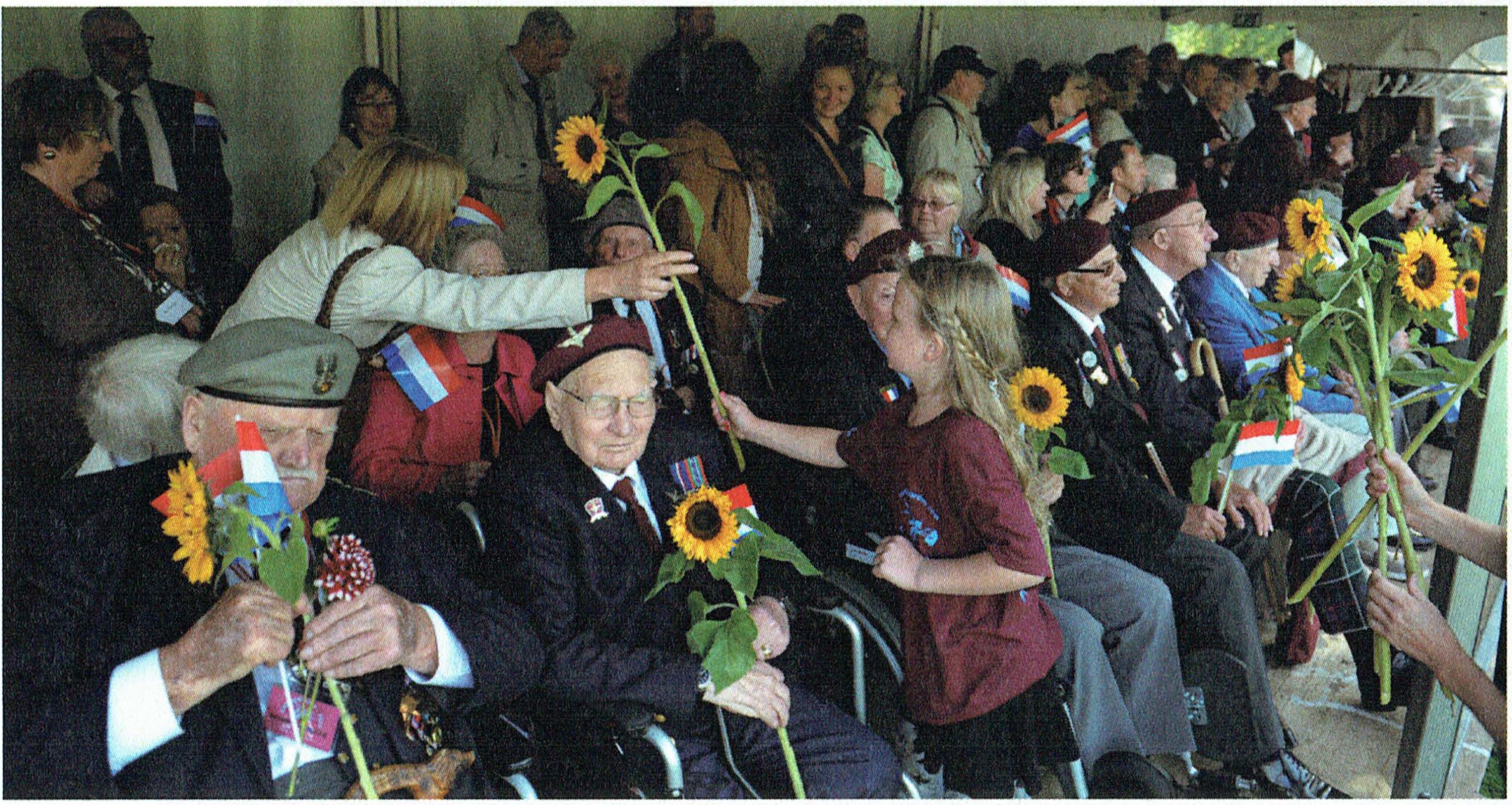
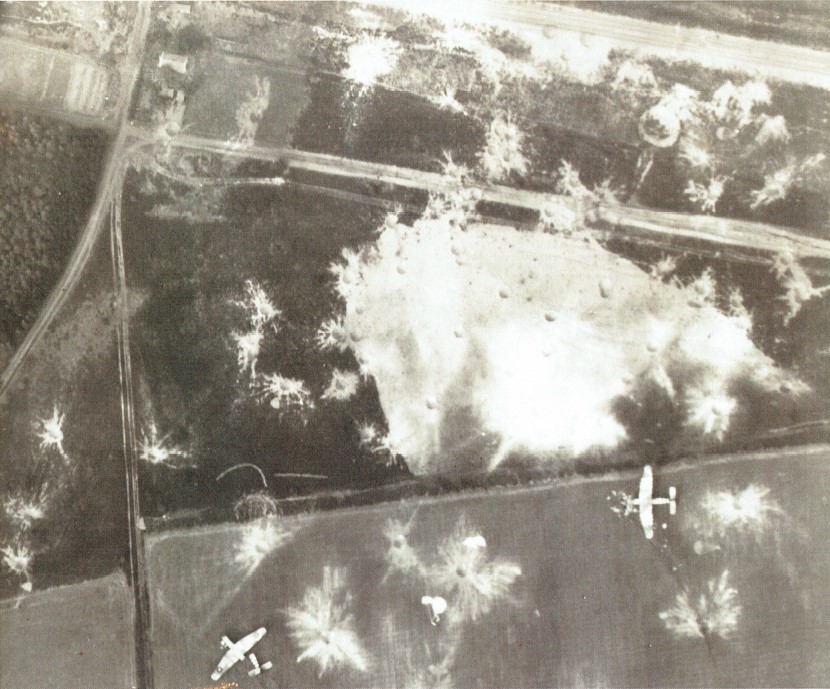

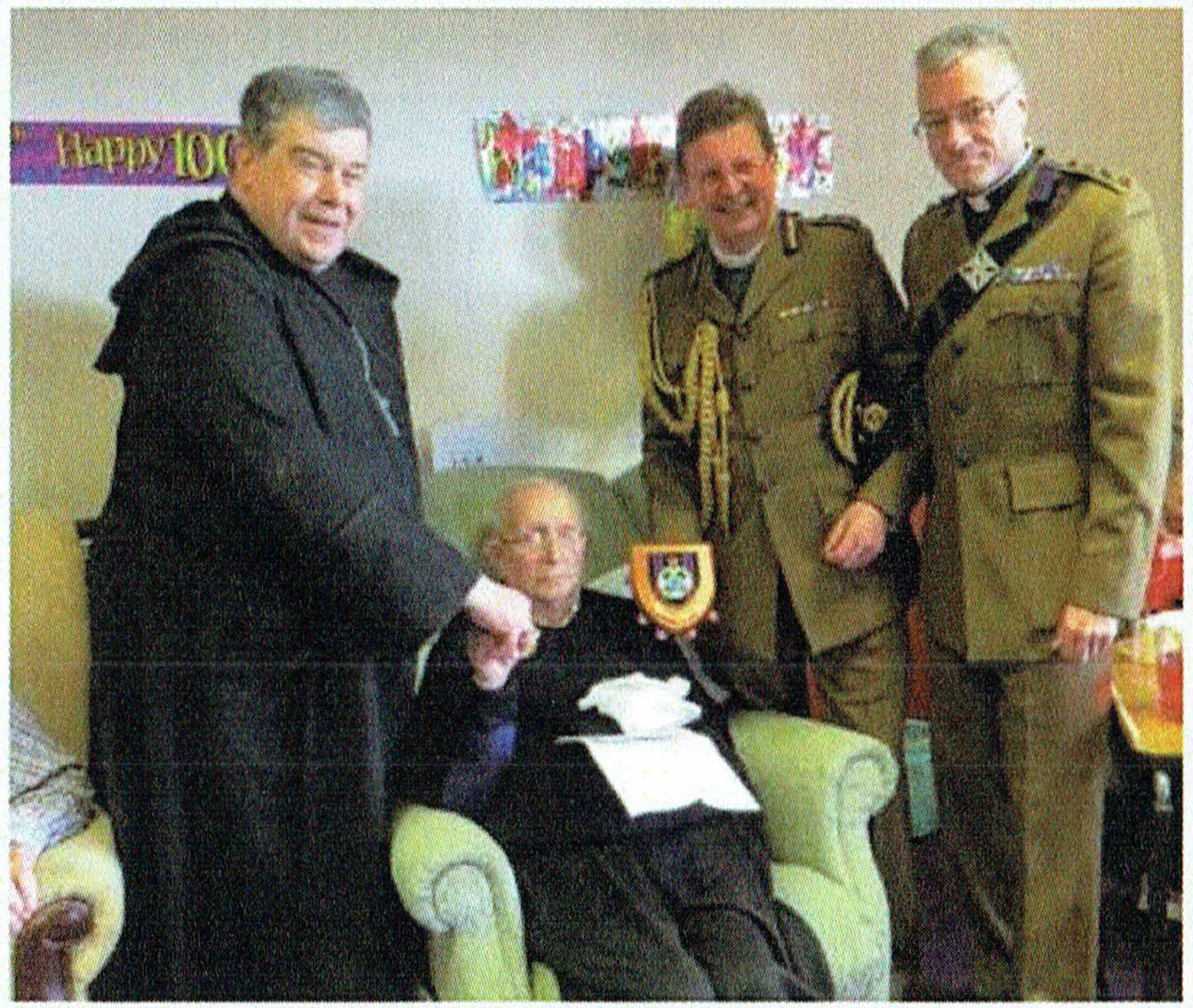
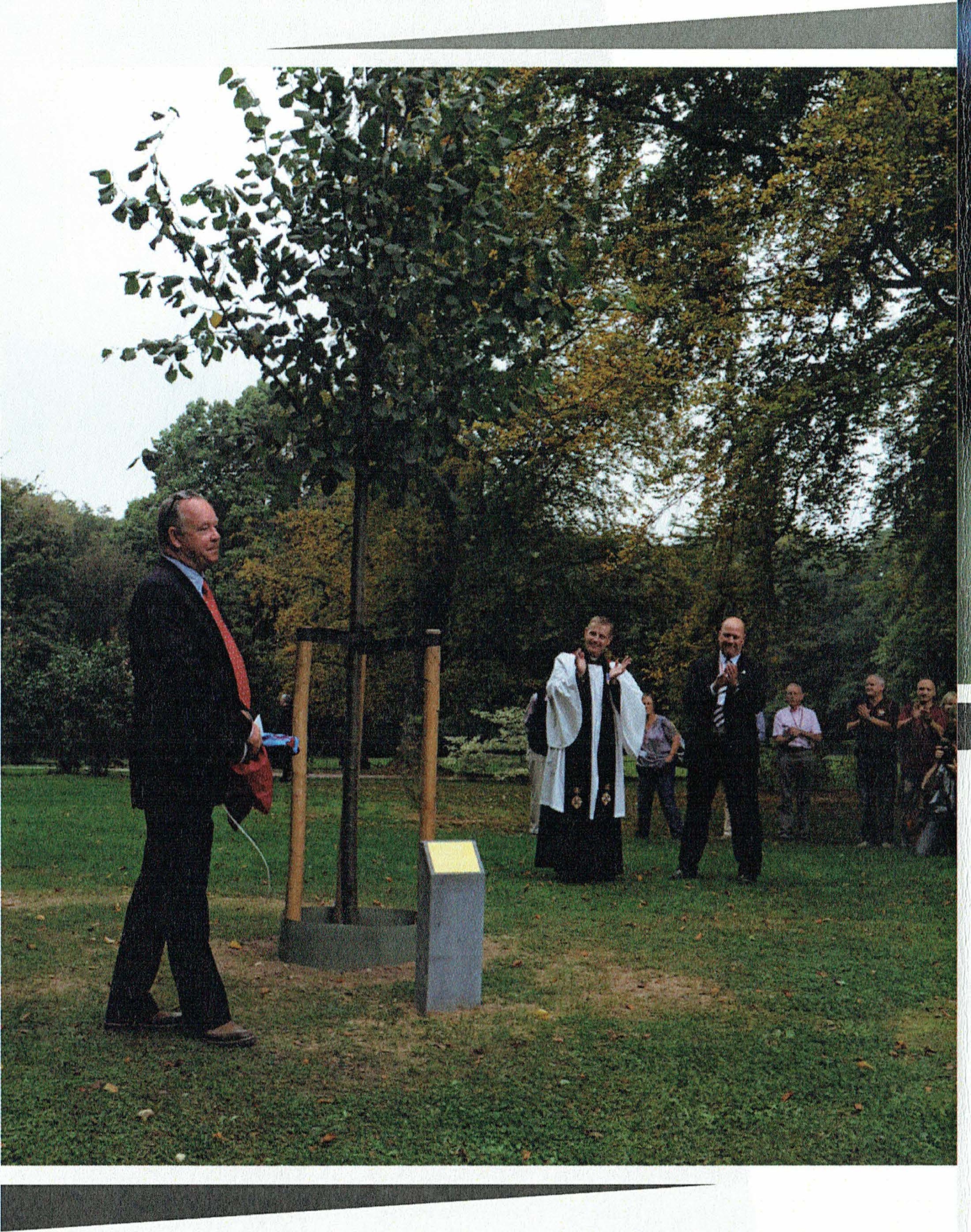
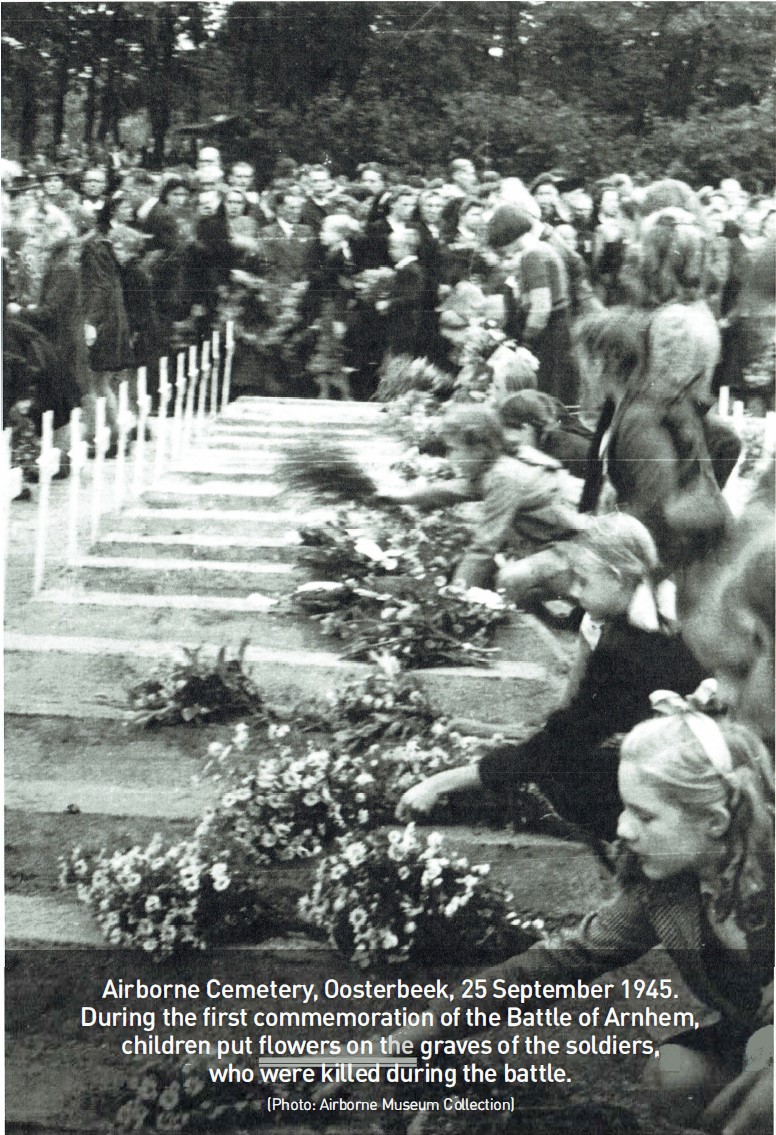
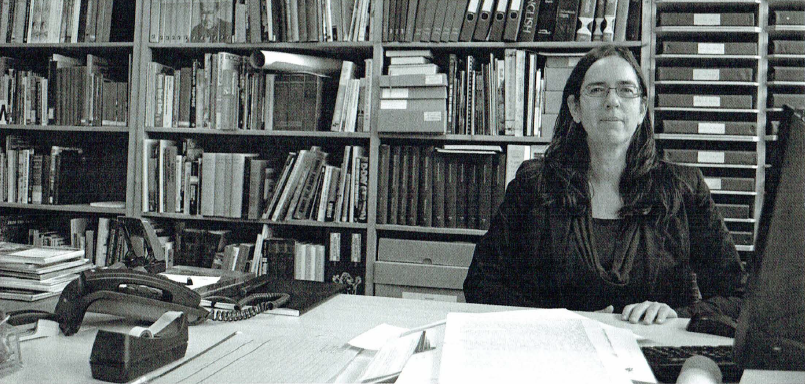
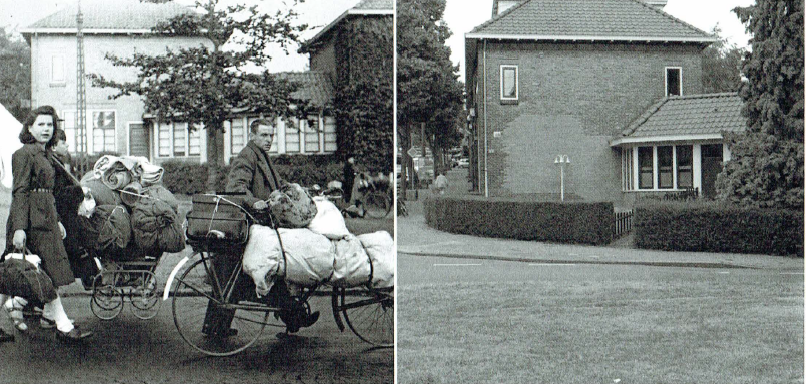

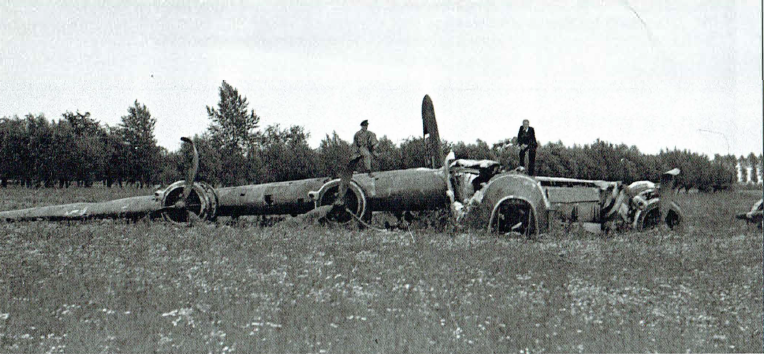
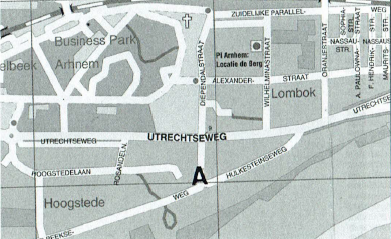
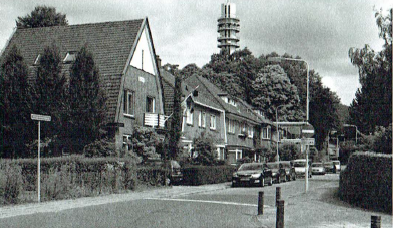

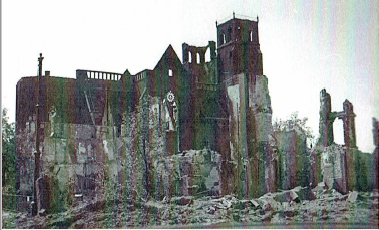
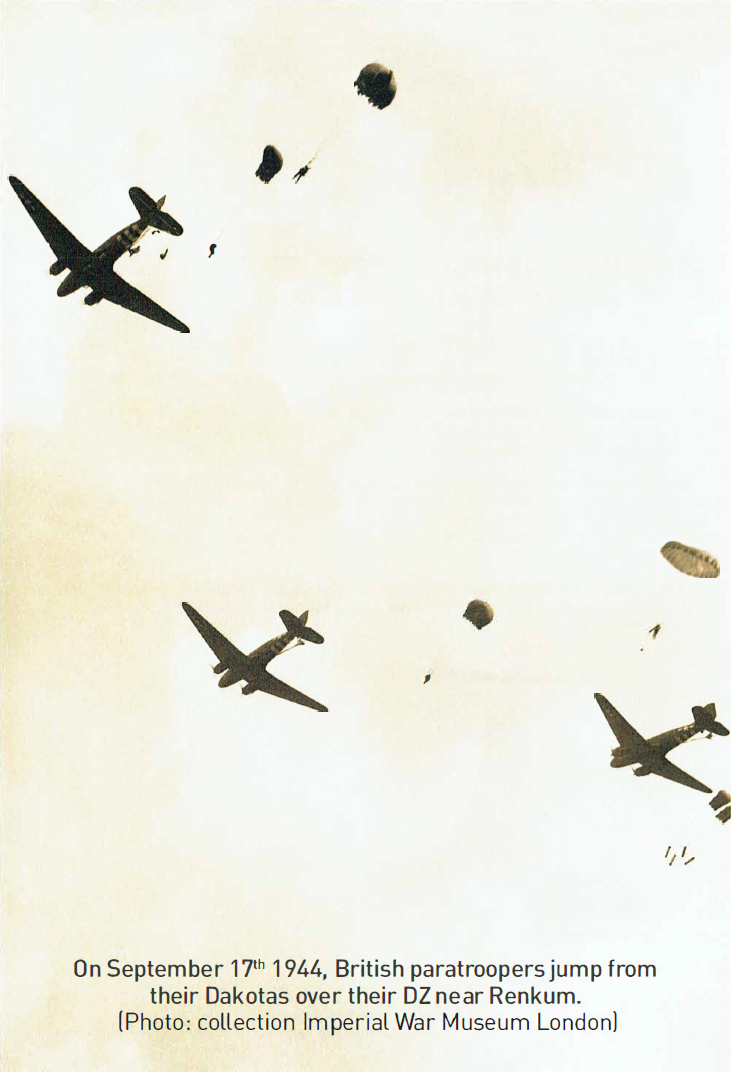
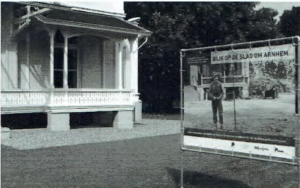 Behind the Museum, exactly on the spot where Maj.Gen Urquhart posed in Sept 1944 for one of the photographers from the Army Film and Photographic Unit, now stands an enlargement of the photo taken then. Thus the visitor can see that he/she stands on very historical ground. IPhoto Robert Voskuil)
Behind the Museum, exactly on the spot where Maj.Gen Urquhart posed in Sept 1944 for one of the photographers from the Army Film and Photographic Unit, now stands an enlargement of the photo taken then. Thus the visitor can see that he/she stands on very historical ground. IPhoto Robert Voskuil)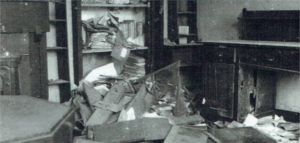 This is how their looted house in the Weverstraat in Oosterbeek looked like,
This is how their looted house in the Weverstraat in Oosterbeek looked like, 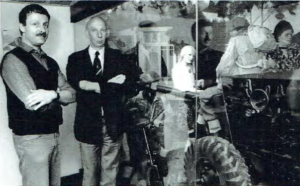 One photo from the 1980 years in the last century. Berry de Reus and Director Caret Wilhelm pose in the basement of the Museum near the Inow no longer existing] large diorama of the British troops entering Oosterbeek. [Photo collection of Berry de Reus)
One photo from the 1980 years in the last century. Berry de Reus and Director Caret Wilhelm pose in the basement of the Museum near the Inow no longer existing] large diorama of the British troops entering Oosterbeek. [Photo collection of Berry de Reus)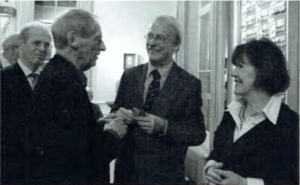 One of the many people who attended the reception on 28 November 2013 to mark Berry de Reus’ retirement and to bid him farewell, was Jaap Korsloot, who earlier, amongst others, did a lot of work on the Museum archives. To the right stands Berry’s partner Jeannette. fPhoto Robert Voskuil!
One of the many people who attended the reception on 28 November 2013 to mark Berry de Reus’ retirement and to bid him farewell, was Jaap Korsloot, who earlier, amongst others, did a lot of work on the Museum archives. To the right stands Berry’s partner Jeannette. fPhoto Robert Voskuil!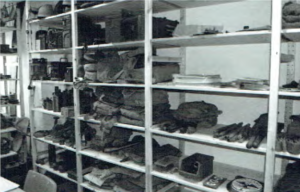
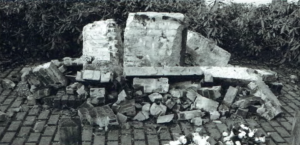 The remains of the dismantled Air Despatch Monument in Oosterbeek.
The remains of the dismantled Air Despatch Monument in Oosterbeek.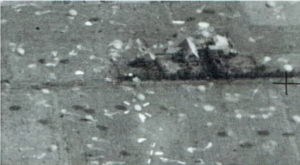 Still’ from a film scene, that was taken by Sergeant Mike Lewis IAFPU). The picture shows part of the front face of the Sinderhoeve building with the name of the farm. IAFPU – film from the Imperial War Museum. Film still: Robert Voskuil collection!
Still’ from a film scene, that was taken by Sergeant Mike Lewis IAFPU). The picture shows part of the front face of the Sinderhoeve building with the name of the farm. IAFPU – film from the Imperial War Museum. Film still: Robert Voskuil collection!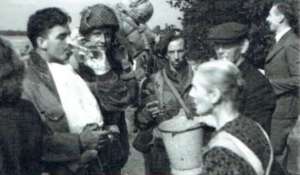 Mr and Mrs Pennings Senior on the road in front of the farm, give water to the just dropped paratroops. To the right Jan Pennings in his best suit. IPhoto Sgt Mike Lewis IAFPU) – Collection: Imperial War Museum London.
Mr and Mrs Pennings Senior on the road in front of the farm, give water to the just dropped paratroops. To the right Jan Pennings in his best suit. IPhoto Sgt Mike Lewis IAFPU) – Collection: Imperial War Museum London.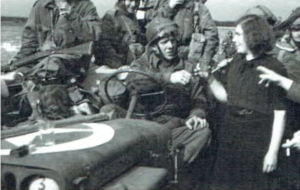 Gerdina Pennings gives a glass of water to the driver of a jeep, who stopped on the road in front of the farm. IPhoto: Sgt Mike Lewis IAFPU] – Collection: Imperial War Museum London.
Gerdina Pennings gives a glass of water to the driver of a jeep, who stopped on the road in front of the farm. IPhoto: Sgt Mike Lewis IAFPU] – Collection: Imperial War Museum London.